Reading to Understand
- Reading to Understand (8 minutes)
- Working with Context Clues (5 minutes)
- The Main Idea

Steps for Identifying the Main Idea
- Knowledge Check
- Academic Reading Challenges (7 minutes)
The main idea is the point or message - what an author presents and what a reader takes from a text.
Searching for that main idea is a very important activity in understanding a text. It is usually found in the opening paragraph when the author is setting up the topic and expressing the thesis.
However, the location can vary according to the type of reading. For example, a research article's main idea is toward the end, whereas a persuasive essay's main idea is conveyed at the beginning.

Pre-read to Determine the Overall Topic
Examine the title and then skim the text to determine who or what the reading is about. If you see the same word repeated you know that it is likely the topic or at least an important element of the topic. The topic should be a noun or a noun phrase such as "online education." The topic itself does not convey any meeting us you must read on to determine the main idea.
Ask yourself questions about the text as you read in-depth. Pay close attention to the introduction, the first sentence of body paragraphs, and the conclusion. In these places, the author typically states and supports the main idea.
Questions to Ask Yourself While Reading :
- What elements make up this topic?
- What is the author saying about this topic?
- What does the author want me to know or believe about this topic?
Reflect on what you have read. If the main idea is not immediately apparent to you review the introduction and conclusion. The main idea should be a complete thought such as "because of its flexibility, comfort, and lower-cost online education is increasing in popularity for younger generations."
Questions to Ask Yourself While Reflecting:
- What is the message I take away from this reading?
- What point does the information add up to?
- What idea does the author reinforce in the conclusion?
- What is the final impression I have about this topic?
Finding the Main Idea
Once you believe you have found the main idea, check that each body paragraph relates to that main idea. The body paragraph should include supporting ideas that reinforce and provide greater detail about the main idea.
Some students find it beneficial to sketch the main idea and supporting ideas in their notes as a concept map.

- Previous Page: Working with Context Clues (5 minutes)
- Next Page: Academic Reading Challenges (7 minutes)
- Office of Student Disability Services
Walden Resources
Departments.
- Academic Residencies
- Academic Skills
- Career Planning and Development
- Customer Care Team
- Field Experience
- Military Services
- Student Success Advising
- Writing Skills
Centers and Offices
- Center for Social Change
- Office of Academic Support and Instructional Services
- Office of Degree Acceleration
- Office of Research and Doctoral Services
- Office of Student Affairs
Student Resources
- Doctoral Writing Assessment
- Form & Style Review
- Quick Answers
- ScholarWorks
- SKIL Courses and Workshops
- Walden Bookstore
- Walden Catalog & Student Handbook
- Student Safety/Title IX
- Legal & Consumer Information
- Website Terms and Conditions
- Cookie Policy
- Accessibility
- Accreditation
- State Authorization
- Net Price Calculator
- Contact Walden
Walden University is a member of Adtalem Global Education, Inc. www.adtalem.com Walden University is certified to operate by SCHEV © 2024 Walden University LLC. All rights reserved.
How to Find the Main Idea
ThoughtCo / Mary McLain
:max_bytes(150000):strip_icc():format(webp)/kr01-56a946be5f9b58b7d0f9d8d0.jpg)
- B.A., English, University of Michigan
Questions about the "main idea" of a passage are popular on reading comprehension tests, but sometimes, those questions are pretty difficult to answer, especially for students who are not completely sure they understand what the main idea really is. Finding the main idea of a paragraph or longer passage of text is one of the most important reading skills to master, along with concepts like making an inference , finding the author's purpose , or understanding vocabulary words in context.
Here are a few techniques to help understand what, exactly, is a "main idea" and how to identify it accurately in a passage.
How to Define the Main Idea
The main idea of a paragraph is the primary point or concept that the author wants to communicate to the readers about the topic. Hence, in a paragraph, when the main idea is stated directly, it is expressed in what is called the topic sentence . It gives the overarching idea of what the paragraph is about and is supported by the details in subsequent sentences in the paragraph. In a multi-paragraph article, the main idea is expressed in the thesis statement, which is then supported by individual smaller points.
Think of the main idea as a brief but all-encompassing summary. It covers everything the paragraph talks about in a general way, but does not include the specifics. Those details will come in later sentences or paragraphs and add nuance and context; the main idea will need those details to support its argument.
For example, imagine a paper discussing the causes of World War I . One paragraph might be dedicated to the role that imperialism played in the conflict. The main idea of this paragraph might be something like: "Constant competition for massive empires led to increasing tensions in Europe that eventually erupted into World War I." The rest of the paragraph might explore what those specific tensions were, who was involved, and why the countries were seeking empires, but the main idea just introduces the overarching argument of the section.
When an author does not state the main idea directly, it should still be implied , and is called an implied main idea. This requires that the reader look closely at the content—at specific words, sentences, images that are used and repeated—to deduce what the author is communicating.
Finding the main idea is critical to understanding what you are reading. It helps the details make sense and have relevance, and provides a framework for remembering the content. Try these specific tips to pinpoint the main idea of a passage.
1) Identify the Topic
Read the passage through completely, then try to identify the topic. Who or what is the paragraph about? This part is just figuring out a topic like "cause of World War I" or "new hearing devices;" don't worry yet about deciding what argument the passage is making about this topic.
2) Summarize the Passage
After reading the passage thoroughly, summarize it in your own words in one sentence . Pretend you have just ten to twelve words to tell someone what the passage is about—what would you say?
3) Look at the First and Last Sentences of the Passage
Authors often put the main idea in or near either the first or last sentence of the paragraph or article, so isolate those sentences to see if they make sense as the overarching theme of the passage. Be careful: sometimes the author will use words like but , however , in contrast , nevertheless , etc. that indicate that the second sentence is actually the main idea. If you see one of these words that negate or qualify the first sentence, that is a clue that the second sentence is the main idea.
4) Look for Repetition of Ideas
If you read through a paragraph and you have no idea how to summarize it because there is so much information, start looking for repeated words, phrases, or related ideas. Read this example paragraph :
A new hearing device uses a magnet to hold the detachable sound-processing portion in place. Like other aids, it converts sound into vibrations, but it is unique in that it can transmit the vibrations directly to the magnet and then to the inner ear. This produces a clearer sound. The new device will not help all hearing-impaired people—only those with a hearing loss caused by infection or some other problem in the middle ear. It will probably help no more than 20 percent of all people with hearing problems. Those people who have persistent ear infections, however, should find relief and restored hearing with the new device.
What does this paragraph consistently talk about? A new hearing device. What is it trying to convey? A new hearing device is now available for some, but not all, hearing-impaired people. That's the main idea!
Avoid Main Idea Mistakes
Choosing a main idea from a set of answer choices is different than composing a main idea on your own. Writers of multiple choice tests are often tricky and will give you distractor questions that sound much like the real answer. By reading the passage thoroughly, using your skills, and identifying the main idea on your own, though, you can avoid making these 3 common mistakes : selecting an answer that is too narrow in scope; selecting an answer that is too broad; or selecting an answer that is complex but contrary to the main idea.
Resources and Further Reading
- How to Find a Stated Main Idea
- How to Find an Implied Main Idea
- Finding the Main Idea Practice
- Finding Main Ideas In Paragraphs, http://english.glendale.cc.ca.us/topic.html
- Finding the Main Idea , Columbia College
Updated by Amanda Prahl
- Questions for Each Level of Bloom's Taxonomy
- How to Find the Implied Main Idea
- How to Find the Stated Main Idea
- Find the Main Idea Worksheets and Practice Questions
- Finding the Main Idea Worksheet 2
- How to Outline a Textbook Chapter
- Top 5 ACT Reading Strategies
- Paragraph Unity: Guidelines, Examples, and Exercises
- How To Write an Essay
- How to Find the Main Idea - Worksheet
- How to Teach Topic Sentences Using Models
- How to Boost Reading Comprehension With Reciprocal Teaching
- How to Write a Descriptive Paragraph
- An Introduction to Academic Writing
- What is The Author's Purpose?
- How to Make an Inference in 5 Easy Steps
Main Idea Definition
Main Idea includes the overall message of the text that a writer intends to convey to the audience . Almost all genres of literature have one or two main ideas in them. However, the main idea in literature is not limited to one sentence or paragraph; instead, it develops and grows throughout the text. It works as the central, unifying element of the story which ties together all other elements. In this sense, it can be best defined as the dominant impression or the generic truth incorporated in the literary piece. Etymologically, the central idea is the phrase of two words ‘main’ and ‘idea.’ The meaning is clear that it is the most important thought of a text which enables the readers to understand the layered meanings of the concerned text.
Examples Main Idea from Literature
“ A Red, Red Rose ” by Robert Burns
“O my Luve is like a red, red rose That’s newly sprung in June; O my Luve is like the melody That’s sweetly played in tune. So fair art thou, my bonnie lass, So deep in luve am I; And I will luve thee still, my dear, Till a’ the seas gang dry. Till a’ the seas gang dry, my dear, And the rocks melt wi’ the sun; I will love thee still, my dear, While the sands o’ life shall run. And fare thee weel, my only luve! And fare thee weel awhile! And I will come again, my luve, Though it were ten thousand mile.”
This is one of the famous poems of Robert Burns, a renowned Scottish poet, and lyricist. The poem illustrates the intense love of the speaker for his beloved . The central idea of the poem is love, which the writer has declared in the opening lines. However, he further supports this idea by comparing his beloved with a red rose. He has also employed literary elements to make the readers understand his version of love. To him, beauty is transitory, but his love is holy and eternal. Thus, the central idea plays a great role in advancing the action of this poem.
Invictus by William Ernest Henley
Out of the night that covers me, Black as the pit from pole to pole, I thank whatever gods may be For my unconquerable soul. In the fell clutch of circumstance I have not winced nor cried aloud. Under the bludgeonings of chance My head is bloody, but unbowed. Beyond this place of wrath and tears Looms but the Horror of the shade, And yet the menace of the years Finds and shall find me unafraid. It matters not how strait the gate, How charged with punishments the scroll, I am the master of my fate, I am the captain of my soul.
The poem, having an artistic expression, was composed to illustrate the courageous stance of a person in unfortunate circumstances. The main idea of the poem is the resilience of human spirit in the face of miseries and challenges of life. Despite having troubles and adverse circumstances, the speaker holds his spirit high and face the difficult time of his life bravely. His optimism and ability to overcome the adversity makes him stronger as he calls himself the master of his fate. He is not afraid of the problems and, this belief enables him to overcome any obstacle that comes to his way. Therefore, courage makes up the main idea of the poem.
SCENE I. A desert place. (Macbeth by William Shakespeare, Act I, Scene I)
Thunder and lightning. Enter three Witches First Witch When shall we three meet again In thunder, lightning, or in rain ? Second Witch When the hurlyburly’s done, When the battle’s lost and won. Third Witch That will be ere the set of sun. First Witch Where the place? Second Witch Upon the heath. Third Witch There to meet with Macbeth . First Witch I come, Graymalkin! Second Witch Paddock calls. Third Witch Anon. ALL Fair is foul, and foul is fair: Hover through the fog and filthy air.
This extract has been taken from one of the famous plays of Shakespeare, Macbeth. This is the opening scene of Macbeth in which three witches discuss their next meeting point , where they plan to see Macbeth. This opening scene not only sets the tone of the play but also highlights the recurring motif of the supernatural creatures. The audience immediately gets an idea that the text is about the evil and foul play.
Main Idea Meaning and Function
Main idea serves as the pause for the audience. It provides them an opportunity to understand the writer’s intention or the reason for his writing. It also makes them recognize and appreciate the deeper meanings of the texts. The writers also use it as a tool that enables them to project their inner thoughts and persuade the readers. Moreover, some of the academic writings unconsciously instill main ideas into the subconscious of the readers with ulterior motives which can be good or bad.
Related posts:
- Four Main Types of Sonnets with Examples
- Comic Relief
- Black Humor
- Narrative Poem
- Dramatic Monologue
- Existentialism
- In Medias Res
- Short Story
- Romanticism
- Feminine Rhyme
- Metaphysical
- Auditory Imagery
- Sensory Language
- Implied Metaphor
- Rhetorical Device
- Sound Devices
- Exact Rhyme
- Deuteragonist
- Equivocation
- Science Fiction
- Turning Point
- Supporting Sentence
- Urban Legend
- Antonomasia
Post navigation


Identifying the main idea of the story: A Guide for Students and Teachers
READING FOR MEANING: IDENTIFYING THE MAIN IDEA OF THE STORY
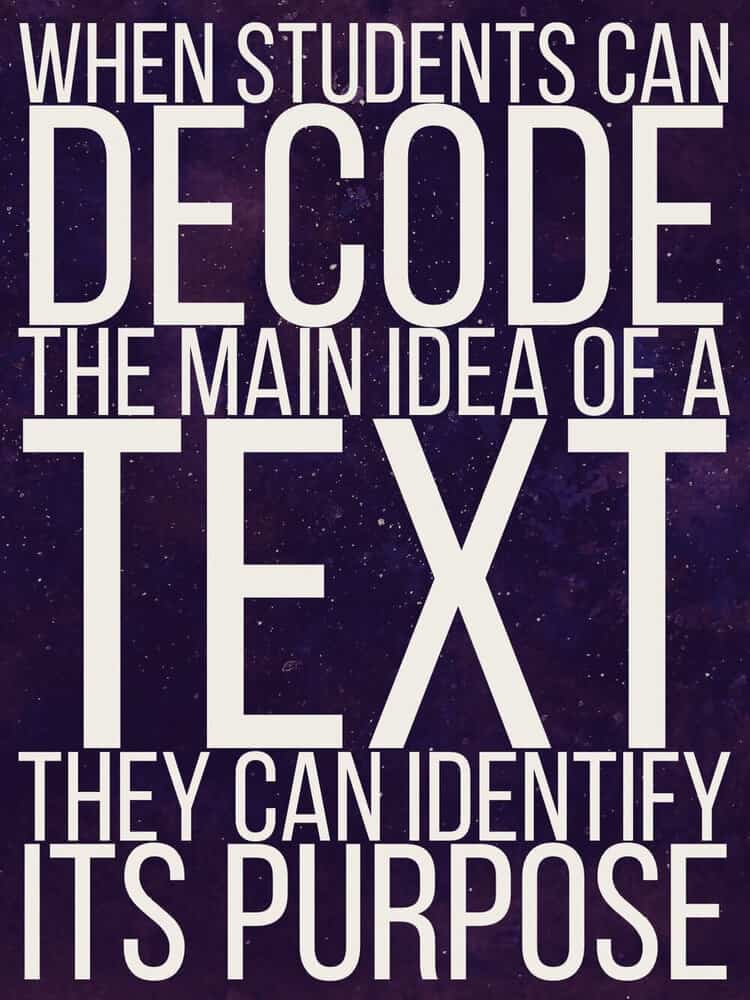
We have all been there, though it can often feel as futile as the search for that proverbial needle in a haystack…
Finding the main idea of a piece of writing can be challenging, but it is an essential reading comprehension skill for our students to develop. Students that become skilled in this art will benefit from it far beyond the perimeters of the school gates. From the small print of an insurance document to writing a book review, the ability to filter a text and identify its central idea is as much a crucial life skill as an essential literacy-based learning objective. Though it isn’t always easy, luckily, there is much we can do to help our students hone their abilities in this area.
WHAT IS ‘THE MAIN IDEA’? DEFINITION
Whether we are talking about the main idea of a paragraph, a poem, a chapter, or a longer text, finding the main idea requires the reader to identify the topic of a piece of writing and then uncover what the writer wants us to know about that topic.
As is so often the case, it is best to start small. When working with students on how to identify the main idea, begin by having students locate the main idea in a sentence before building up to locating it in a longer paragraph. As students gradually build their confidence in identifying the main idea in paragraphs, they will soon be ready to move on to longer texts in the form of chapters and eventually full-length books.
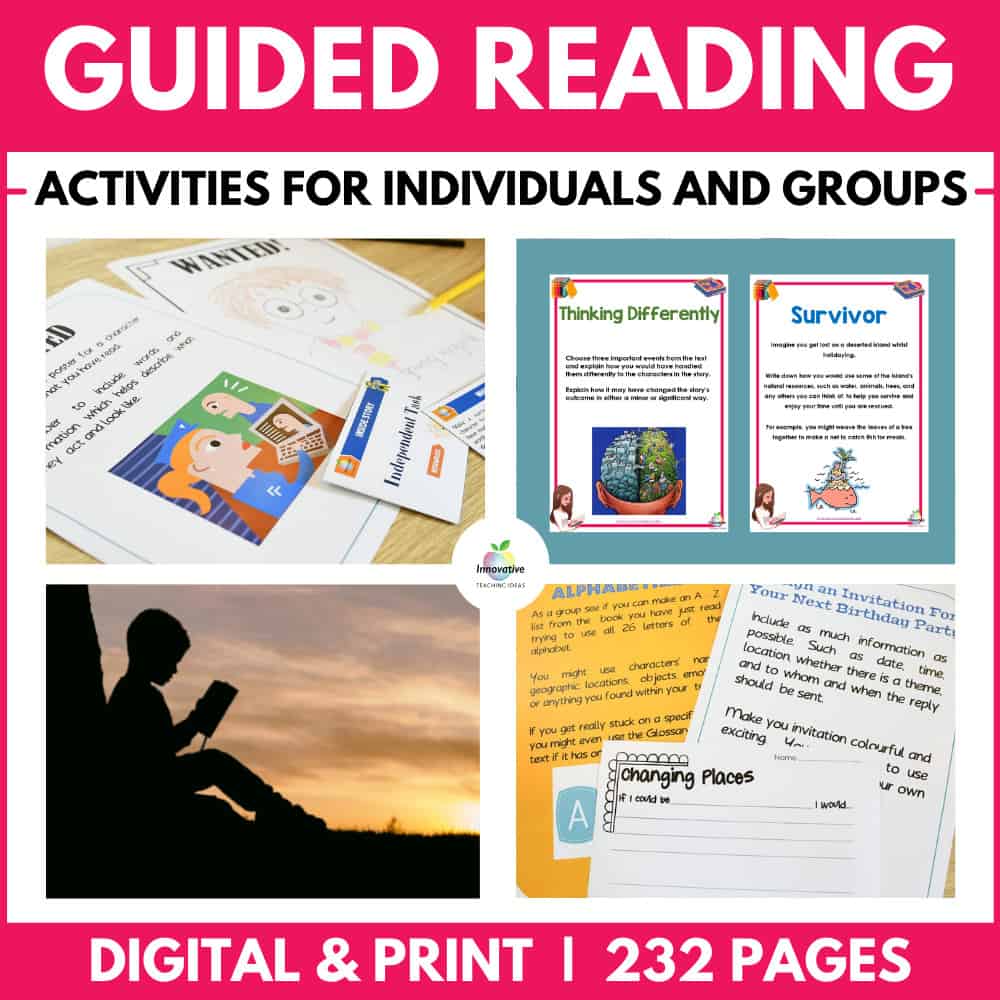
125 Guided Reading Activities
Ensure your students are constantly engaged with these INDEPENDENT & GROUP Reading Activities for ANY BOOK.
⭐⭐⭐⭐⭐ ( 215 reviews )
A WORD ON PARAGRAPHS

The main idea of a sentence is usually fairly straightforward to identify. Often it is as simple as identifying the subject of the sentence. Whole chapters or books, on the other hand, can seldom be easily reduced to expression in the form of a single, main idea. For these reasons, the paragraph offers the student the most suitable format in which to practice their main idea identification skills.
Usually, if the writer knows what they are doing, we can identify a single main idea in every paragraph. We can think of this as the key point that is usually expressed as a topic sentence. It is often found in the paragraph’s first sentence, with subsequent sentences providing the supporting details. It can, however, occur in the middle, at the end, or even be split across the paragraph. It may not even be there at all – at least not explicitly.
Writers are a creative bunch, and so students will require more sophisticated means to accurately identify the main idea in all cases and that is exactly what this article will help you help your students to do.
HOW IS A MAIN IDEA EXPRESSED?
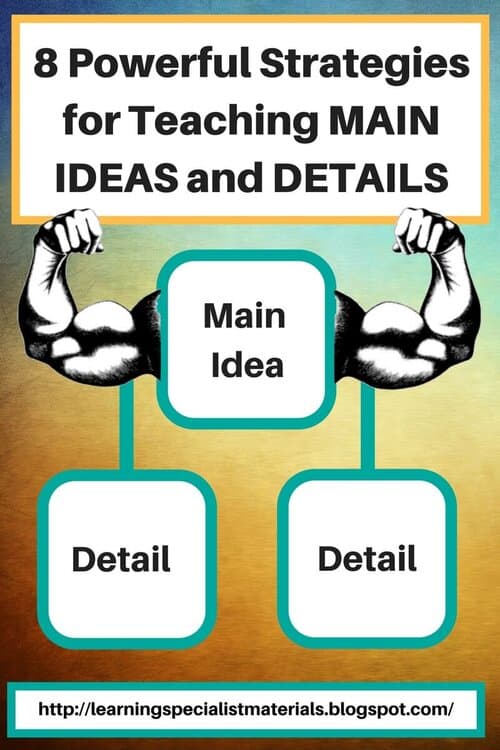
It can appear to be a reasonably clear-cut task to define the main idea, so why is it often so problematic for students to identify it? Well, the truth is that it needn’t be so. Often the central concept is expressed directly in the text and is as easy to identify as your own face in the mirror.
However, the main idea will not always be expressed so explicitly, and students must learn to identify it, whether it is expressed directly or merely implied, if they are to fully comprehend what they are reading.
THE STATEMENT OF THE MAIN IDEA
Attention is the key to pulling the main idea from a text, whatever the genre. Students need to identify the most relevant information from the work and use it to develop a statement expressing what they perceive as the main idea.
We can refer to this as The Statement of the Main Idea . This statement should be a lean sentence or two. The process of composing this statement starts with asking questions about the text. Not all questions will apply to every text, but they will provide a good starting point for extracting the main idea from any piece of writing.
● Who – Can the student identify the person or people the text is about?
● What – Can the student identify the topic or underlying theme of the text?
● When – Can the student identify a reference to a specific time or period?
● Where – Can the student identify a specific place or a setting ?
● Why – Can the student identify a reason or explanation for what happens in the text?
● How – Can the student identify a method or theory in the text?
These questions, and variations of these questions, can help students draw out what the text is about. The two most important questions of those above are who and what . These will sufficiently elicit the information required to identify the main idea in most circumstances. But, the actual litmus test of whether the student can absorb the text’s central idea is whether or not they can summarize what they have read in their own words.
The Litmus Test: Summarizing and Paraphrasing
We know through our experience in the classroom that learning through teaching is a highly effective instructional strategy. It also offers teachers opportunities to observe and assess their students’ grasp of the concepts they have been working on. Similarly, when we ask our students to summarize or paraphrase the main idea of an extract, we are creating an opportunity to observe their comprehension of what they have read and their ability to identify the main idea therein.
You can also encourage students to regularly practice these skills by challenging them to paraphrase and summarize things you have said or read to them in class, even during lessons entirely unrelated to literacy. Encourage them to be concise and to the point; you may even wish to set a word limit of 10 or 15 words within which they must express the main idea. Keep it lean!
STRATEGIES FOR SUCCESS IN IDENTIFYING THE MAIN IDEA
Get The Gist
In this method, give each student a copy of a nonfiction paragraph. If you wish, you can differentiate for students’ different abilities by choosing extracts of varying complexities. Regardless of the level of difficulty, the approach will remain the same. Have students:
1. Ask themselves who or what the paragraph is about.
2. Ask themselves what is the most essential information about the who or what.
3. Restate the main idea in 10 words or less.
You can model this strategy for your students by first walking them through the process. Project the text onto the whiteboard for shared reading and, with focused support and prompting, have them answer the initial questions.
Part 3 of the process above can be undertaken as a piece of shared writing which will model the correct approach before students begin to do it independently. Later, when students have written independent statements of the main idea, they can compare their responses and offer each other feedback. After feedback sessions, they can be given a further opportunity to redraft and modify their statements for accuracy and brevity.
Through these processes, students will improve their ability to identify and express the main idea clearly and concisely.
Get the Gist – Longer Texts
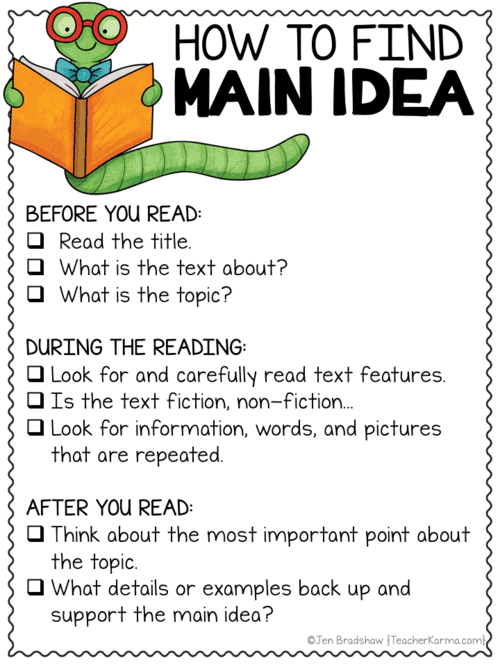
As we mentioned earlier, it isn’t always easy to reduce a longer extract, such as a chapter, down to a single central idea – much less a whole book! There will be times, however, when students will be asked to do just that. They will need a systematic approach to help them in such circumstances. The following process provides for a practical approach:
1. Look at the title – Often, the title provides a good indication of the topic of the text or at least helps to orientate the reader in the direction of the main idea.
2. Look at the extract’s first and last sentences/paragraphs – Often, the main idea will be introduced and summarized respectively in these parts of the text.
3. Look for repeated words and phrases in the extract -The frequency with which they occur will be a strong indicator of their relative importance and will point students toward that elusive main idea.
4. Instruct students to ask themselves, “ What does the writer want me to know? ” – Answering this question successfully will require them to uncover the text’s main idea.
As the students work through the above steps, they can highlight, underline, or circle the keywords and phrases and then use these to help them form their main idea statement.
HOW TO LOCATE THE MAIN IDEA WHEN IT IS IMPLIED
Inferring the main idea requires students to look for patterns in the details as they read. When the main idea is explicit, the student must first identify the topic of the writing before determining what it is the writer wants the reader to know about it. If the main idea is not stated explicitly in a sentence or paragraph, then it is implied, and students must consciously work to uncover it by analysing the details to infer the main idea. Conscious practice of this strategy will soon see it become second nature, and the student will quickly become skilled in identifying the main idea even when it is not stated explicitly.
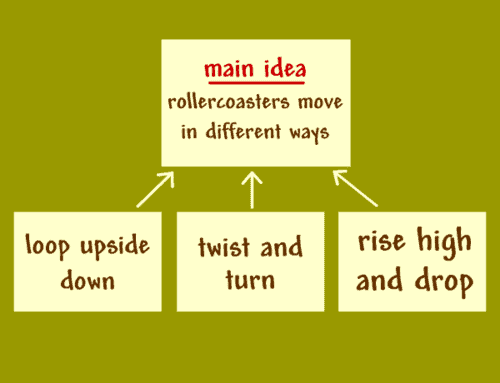
To efficiently identify the main idea in a piece of writing, students should first determine the text’s topic. Then, they will need to work out what it is the writer wants us to understand about that topic. This is the essence of how to identify the main idea.
Students should understand that the main idea may not always be explicit, and they may need to work hard to uncover precisely what the text implies. Regardless of whether the main idea is explicit or implicit, every paragraph will have the main idea. Students should understand that it can be located at the beginning, in the middle, at the end, or even be split up throughout the paragraph.
With perseverance and hard-earned experience, students can use various methods and, at times, a fusion of these methods to uncover the main idea with speed and accuracy. Soon they will be able to apply these methods to a broad range of texts over a wide range of lengths and complexities.

Teaching Resources
Use our resources and tools to improve your student’s writing skills through proven teaching strategies.
MAIN IDEA GRAPHIC ORGANIZER (FREE DOWNLOAD)
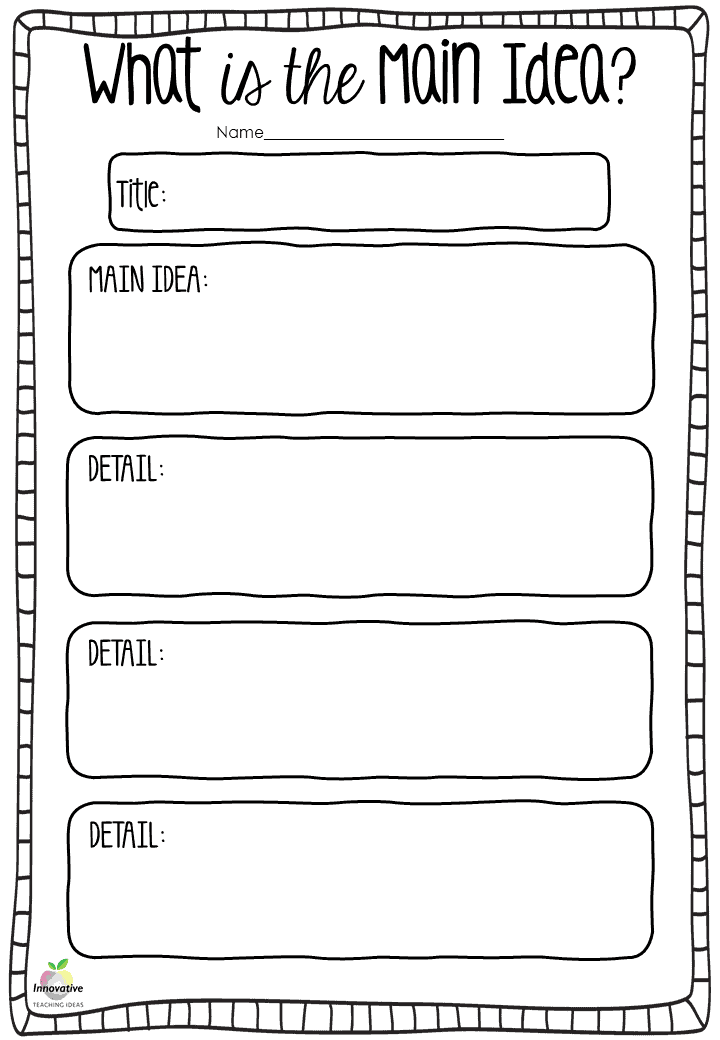
VIDEO TUTORIAL ON TEACHING THE MAIN IDEA
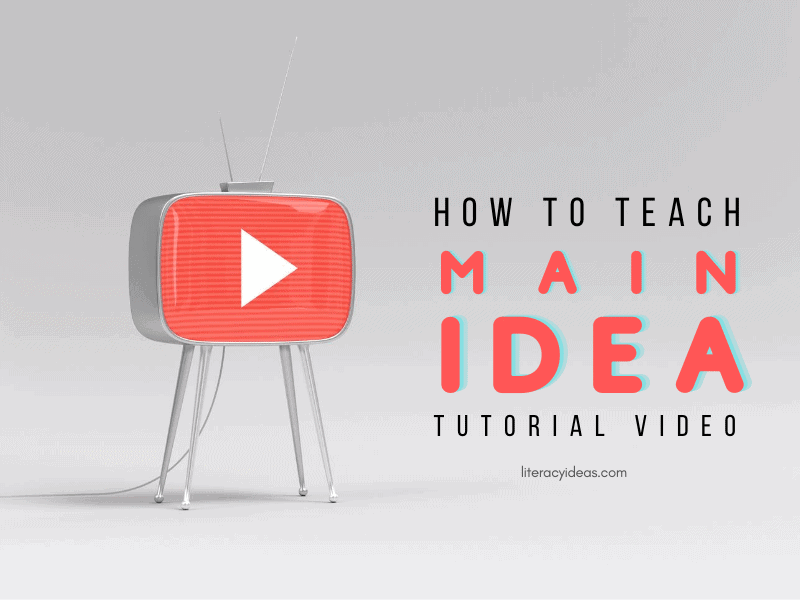
ARTICLES RELATED TO THE MAIN IDEA OF THE STORY
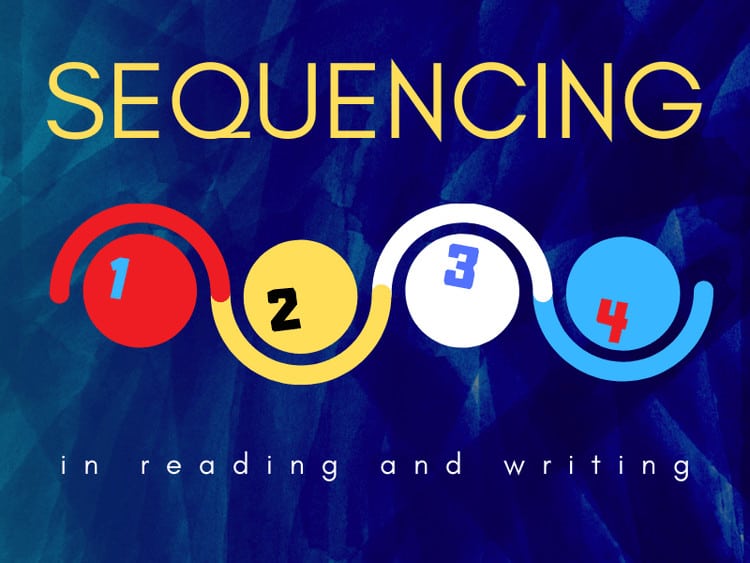
Sequencing events in reading and writing

Teaching Cause and Effect in Reading and Writing
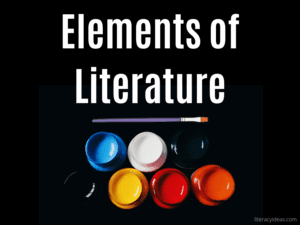
Elements of Literature

Teaching Compare and Contrast
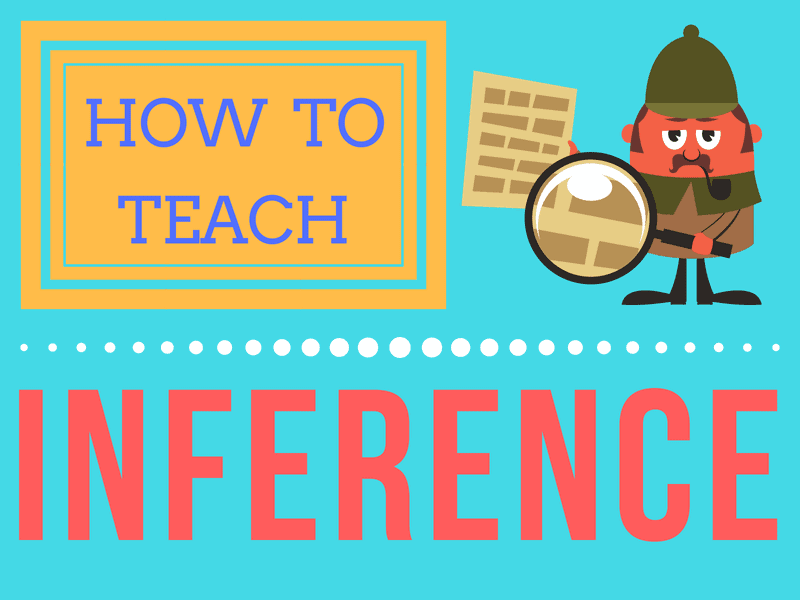
What Is An Inference? And How To Teach It.

How to find the main idea
Determining the main idea of any text can be tricky. Let’s take a look at some helpful ways to zero in on it.

Author Taylor Hartley
Published January 19, 2024

Published Jan 19, 2024
- Key takeaways
- Think of the main idea as the point – The main idea is the primary argument or claim discussed by the author, around which all other supporting details and explanations revolve.
- Make sure you read the full text – You can determine the main idea by reading the full text, annotating its key points, summarising, and looking for any repeating ideas or statements.
- There are a few key questions to ask – While reading, it’s always important to look for the Who, What, Where and Why. These details will help explain why the author believes what they do.
Table of contents
What exactly is the main idea?
How to find the main idea in five easy steps.
- Questions to ask when trying to find the main idea
- Watch out for distractors
The main idea of a text can be a difficult thing to nail down, but it’s the most important detail of any passage you come across. As you travel along your journey towards mastering reading comprehension, you’ll need to build a habit of figuring out what the main idea is. Once you’ve accomplished that, you’ll have a better chance at consistently understanding even the most complicated of paragraphs.
The main idea is the central argument or point a paragraph is trying to communicate. It’s often the first claim an author makes when they begin their work but it can also be formed based on key details and facts dispersed throughout the body of a paragraph, too. Think of the main idea as the anchor of a paragraph, holding the passage steady and providing a foundation for other important points.
Is there a difference between the central idea and the main idea?
You might be a bit confused if you discover people referencing a “central idea,” of a paragraph or essay. But fear not! The central idea and the main idea are one and the same. The central idea represents the same key talking points and details as the main idea–the primary argument an author is trying to make.
Is there a difference between a supporting detail and a main idea?
Even though the central idea and the main idea are the same, there are a few differences between the main idea and it various supporting details. Supporting details are another important part of reading comprehension, as they provide some much needed context, or explanation of the overall main idea.
A supporting detail might go into greater detail on a specific topic, and give you a bit more understanding of the main point the author is trying to drive home. However, these supporting details don’t exist as their own main ideas, they’re simply there to support the main idea and reinforce it.
Now that you have a basic understanding of what the main idea is, you’ll need to start learning ways to identify it when you encounter it in the wild. Follow along as we walk through some helpful tips on pinpointing the main idea of a passage.
1. Identify the topic.
One of the first tools you can use for locating the main idea is referencing the title of a paper or any subtitles used throughout. Titles are a great way of gaining a grasp on the central topic of an author’s argument. Take the title of this article, “How to find the main idea.” We can learn a lot about what a piece of writing is about by looking at its title.
2. Read the entire passage.
The second step in finding the main idea? You guessed it, thoroughly read the passage so you can get a firm handle on what it’s trying to say. You might be tempted to skim the writing to save time, but it’s important to read each sentence with intent so no details go unseen. Remember, even the smallest detail can provide you with the extra confidence and understanding you need to define the main idea.
3. Annotate as you go, underlining key points or ideas you see.
One helpful tip to help guide your understanding of the main idea is to annotate, or take notes, while you read the text. Doing this will give you a brief but helpful outline of the main points the passage makes. You can look back through your notes once you’re done reading and use them to solve the main idea puzzle. Remember to write down any details you find particularly impactful.
4. At the end, summarise the passage and what you think it’s arguing.
When you’re finished reading and annotating, use what you’ve learned from the text to form a summary of the entire passage. Your summary should include the main arguments and supporting evidence the author used to get their point across. By creating a summary, you’ve reinforced the main ideas of the text in your head, making it easier to discover what the author is really trying to say.
5. Read the first sentence and last sentence and look for repeating ideas in your annotations.
The main idea is often expressed in the first few lines of a text and reiterated in the closing lines of a passage. Knowing this, take a good look at both the first and last lines of a paragraph, and see if there are any recurring details or statements within each one. If there are similarities, there’s a good chance that these statements reflect what the main idea is.
Questions to ask when trying to find the main idea
Although it’s important to take note of each detail you come across in a passage, some can be more valuable when trying to determine the main idea. These details are key parts of the summary you’ll need to create. They’re known as the Who, the What, the Where, and the Why.
The Who relates to the subject of the text; the person or thing the passage is describing. It’s most often a person or group of people, but it can also range from animals to robots to insects! Identifying the Who is an important part of grasping the main idea, because you’ll need to determine just who the author is writing about if you’re going to figure out what the author is trying to say about them.
What is happening within the passage? What actions are taken by the Who? These actions, or reactions, are known as the What. This is the meat of the paragraph, the behaviours or movements of characters and people that the author uses to describe what’s happening in their writing.
The When is another important detail you’ll need to define as you discover the main idea. The When of a passage is the time period the paragraph itself takes place in or references. Think of the When as a date on a calendar. The Who and What you’ve already defined, but on what date – or at what time of the day – do they appear?
What is the setting or location of the paragraph? Where does the action take place? Is it in a specific state or country, or maybe a specific city or neighbourhood? By defining the Where, you’ll be able to determine how the setting influences the main idea. Maybe there are specific laws or rules tied to the setting that affect the main idea, or maybe the geography of the setting affects what the author is trying to say about the region and the people who live in it. No matter what the Where is, you need to define it so that you can understand how the setting of a passage relates to the main idea.
And most importantly, why?
The Why is perhaps the most important piece of the main idea puzzle. To define the Why, ask yourself how the author explains the reasoning behind their argument. Why do certain things work the way they do? Why do people act in the ways that they do? The answer to these questions are within the text, and they’re probably the most important facts regarding the main idea. If you can define the Why, or the explanation for why the author thinks the way they do, you can find the main idea.
Watch out for distractors
As you work your way through a multiple-choice test, reading comprehension questions will normally ask you to pick the main idea out from a collection of possible answers. The creators of these tests can be tricky, and might try to mislead you with answers that don’t actually align with the true main idea.
Because of this, it’s important that you read the passage carefully, paying close attention to the little details throughout that might clue you in to the main idea’s meaning. Make sure to come up with your own main idea, and don’t rely on the answers provided to you by the test. Wrong answers are often either too narrow in their description of the text, too broad, or make claims that are contrary to the argument posed by the author.
Creating your own outline of the passage once you’ve carefully read it will help you summarise the text, pick out its key arguments, and determine the best answer for what the main idea is.
Explore the main idea with DoodleEnglish
DoodleEnglish is an app that’s filled with thousands of fun, interactive exercises covering grammar, punctuation, spelling and more!
Designed by teachers, it creates each child a unique work programme tailored to their needs, boosting their confidence and skills in English. Try it for free today!

FAQs about the main idea
The main idea should include the main talking points of a paragraph. Think of it as a summary of the author’s writing that represents their central argument. The main idea includes the key statements, facts, or opinions the author chooses to include that embody what they’re trying to say.
There are several strategies you can use to help you find the main idea. Techniques such as looking at the title of the work, or any subtitles, writing down your own summary of the text, looking at the first and last sentences of a paragraph, and identifying recurring ideas are ways to discover the main idea. You can also take notes throughout your reading so that you have a brief outline of key details.
Yes, it’s extremely important for you to read the passage in its entirety if you want the best chance at understanding its main idea. You may feel tempted to skim or speed-read your way through an essay, but be wary that you might miss certain details or key ideas that could have helped you define the central argument. The best way to go about defining the main idea is to read each sentence intently.
The central claim and the main idea are synonymous with one another, meaning they represent the same thing. If you’ve identified the central claim of a passage, you’ll be happy to know that you’ve also found the main idea!

Try DoodleEnglish for free!

Related posts
What are speech marks?

From novels to news reports, speech marks are used everywhere
Spelling activities for KS2

There are lots of fun ways you can liven up spelling practice!
What is SPaG? A guide

SPaG is a really important concept in English, but what does it mean?
What we offer
Quick links
All rights reserved.

Are you a parent, teacher or student?
Get started for free!
Maths information pack
We ask for your contact info so we can send our info pack directly to your inbox for your convenience, exam prep information pack, case studies information pack.
Book a chat with our team

I’m new to Doodle

My school is already using Doodle

Information pack
We ask for your contact info so that our education consultants can get in touch with you and let you know a bit more about doodle., student login, which programme would you like to use.
DoodleMaths
DoodleTables
DoodleEnglish
DoodleSpell
If you’d like to use Doodle’s browser version, please visit this page on a desktop.
To log in to Doodle on this device, you can do so through our apps. You can find out how to download them here:
Finding the Main Idea – Reading Comprehension Strategy Lesson Plan
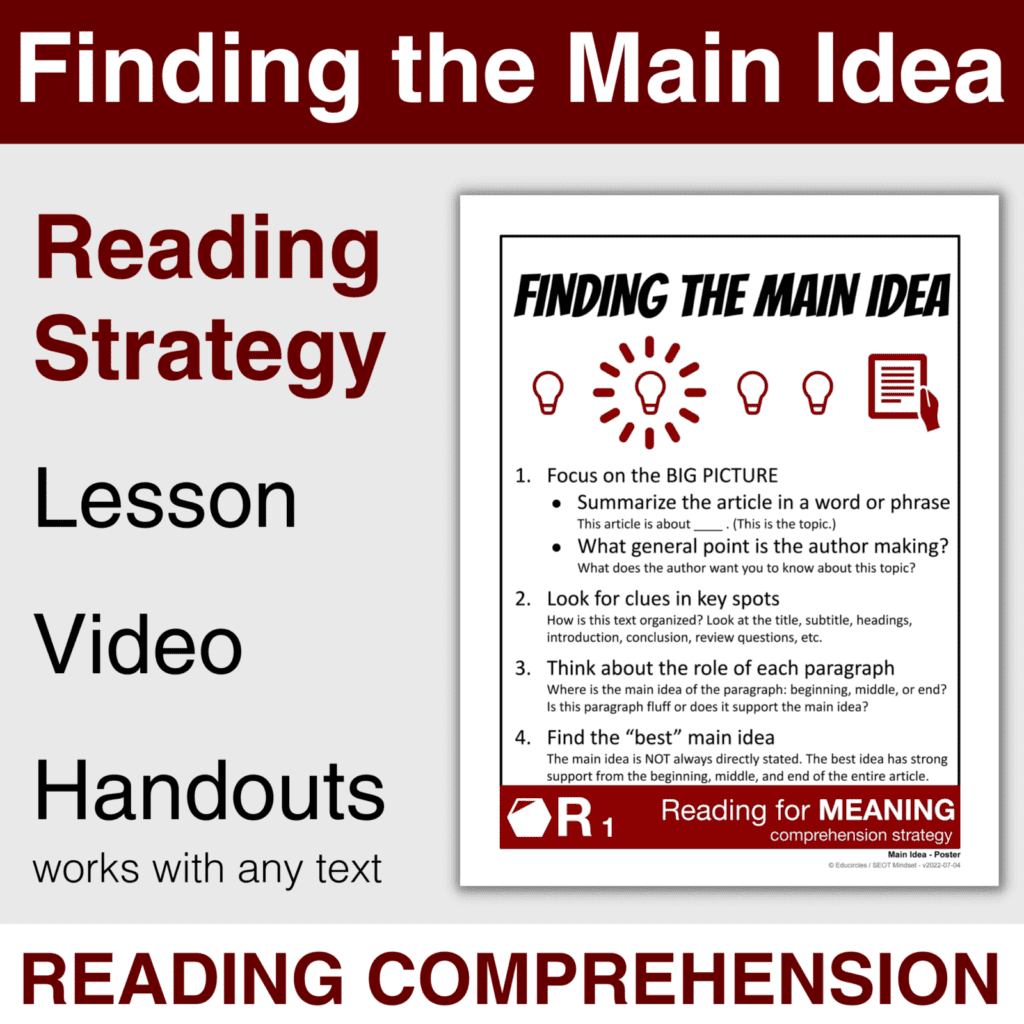
Finding the Main Idea lesson plan UPDATE Nov 21, 2022
Finding the Main Idea is more than just figuring out what general point the author is trying to make.
It’s about recognizing that we can come up with several main ideas, but the “best” main idea has strong support from the entire article.
Use this lesson to give students a process to find clues in the organization of the text.
Active reading means looking at the information in each paragraph and deciding if it is “nice to know” side information or essential information that develops the author’s point.
FINDING THE MAIN IDEA Reading Strategy
How to evaluate and find the best main idea (4 pro tips):.
- Focus on the BIG PICTURE (the entire article). Summarize the entire article in a word or phrase. What general point is the author trying to make?
- Look for clues in key spots. (How is the text organized?)
- Think about each paragraph. What is this paragraph about? (Where is the main idea in the paragraph? Beginning? Middle? End?) What role does this paragraph play?
- Find the “best” main idea. The main idea is NOT always directly stated. The best idea has strong support from the beginning, middle, and end of the entire article.
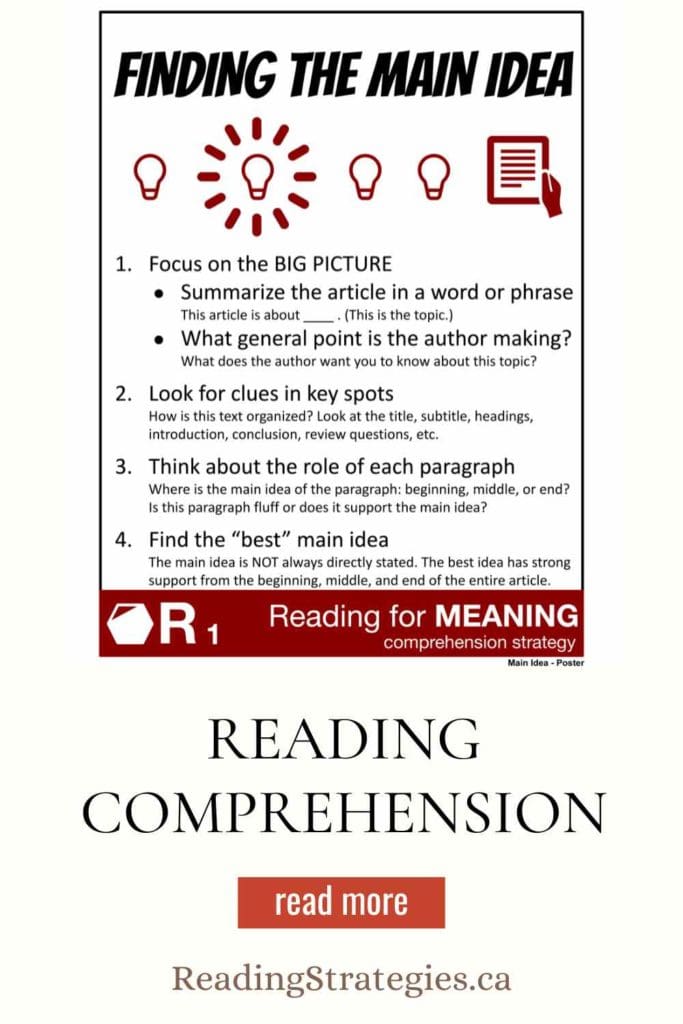
If you want this product with reading texts, please check out our Reading for Meaning Comprehension Strategies bundle.
Watch the FREE Reading Comprehension Video .
Hi everyone it’s Mike from Educircles and today is part of our Reading for Meaning series, we’re going to be talking about the comprehension strategy called Finding the Main Idea.
Now before we talk about this reading strategy , let’s review active reading.
- Active reading means we think about the text as we read.
- We don’t just say the words – we think about the words and what the words actually mean.
If we use strategies, we can get better at reading. Comprehension strategies help us figure out what is happening in a text.
Today, we will use a strategy called Finding The Main Idea.
Finding The Main Idea is about looking at the big picture of an article. We’re asking what general point is the author trying to make.
It’s not always easy to find the best or biggest main idea.
- The author will write several sentences and paragraphs – and in the article, there will be several key points and ideas.
- The best main idea is the overall central idea of the entire article.
- So, in this example, the big idea might be that this is a soup ladle.
Finding the main idea is like looking for constellations in the night sky.
A constellation is a group of stars in a recognizable pattern.
For example, this is the Big Dipper. If you know where to look it’s easier to see the patterns.
(Did you know that if you extend the line between the last 2 stars in the Big Dipper, you can find the North Star?)
When we read, we need to look for clues in key spots of the text.
- We need to ask ourselves, how is the text organized?
- We think about the big picture and we try to look at the entire article.
Here are 4 pro tips to help you find the main idea.
Find the main idea – pro tip #1: focus on the big picture.
Pro Tip #1 is to focus on the big picture – that means thinking about the entire article.
Summarize the entire article in a single word or phrase. What general point is the author trying to make about that topic?
We’re going to be looking at a series of examples.
Finding the Main Idea – Example #1: Photograph
Let’s look at example #1 which is a photograph.
- Here’s the photo.
- Summarize this entire media text in a single word or phrase.
- In other words, what is this image about?
What is the topic?
You might say stars, night, the universe, being alone, life on other planets…
Then, we have to ask ourselves what is the author saying about the topic. Maybe that “astronomy is the science of stars in space” or maybe the author is trying to say that “night is beautiful”, “the universe is expanding”, “being alone can be a good thing”, “Is there life on other planets?”
Any of these could be the main idea, but which one is the best main idea?
We need to try to figure out what is the photographer trying to say with this photo? Maybe the message is that “night is beautiful” or “being alone can be a good thing”. Or, maybe the photographer is trying to capture a sense of wonder about life on other planets. We need more information to figure out which of these might be the best main idea. Maybe there are other clues somewhere else.
Pro Tip #1 Recap
Let’s review Pro Tip #1.
Focus on the big picture – which means the entire article. Try to summarize the entire article in a single word or phrase. Ask yourself, what general point is the author trying to make.
Find the Main Idea – Pro Tip #2: Look for clues in key spots.
How is the text organized? Is there a title or subtitle? Are there headings or subheadings? Is there an introduction? Body paragraphs? A conclusion? Are there review questions?
Let’s look at example #2 which is an informational text that has 5 paragraphs.
Let’s zoom in.
Lorem ipsum is placeholder text that we use in web design. It gives us a sense of layout without having to use actual sentences. Many people just look for meaning in the sentences, but we can find a lot of clues hiding in the text organization.
That’s why in this lesson, there are fake words in the sentences. It’s to help us focus on the text form and structure instead of the words themselves.
Pro Tip #2 is about look for clues in key spots and the guiding question right now is how is the text organized?
Here’s the typical format for most informational texts.
- You have a title which gives us a big hint about the topic and the general point.
- The beginning of the article usually introduces what we’re going to find out in this article.
- The middle of the article usually includes supporting details that the author uses to explain their point
- Finally, at the end of the article, we often see a conclusion that summarizes what the author just told us.
Finding the Main Idea – Example #2: Five Paragraph Essay
This is a 5 paragraph essay.
- We have a catchy introduction to hook the reader.
- The last sentence in the introduction is usually the thesis or main idea and a quick introduction to the 3 ways the author is going to prove their point.
- Then in the body paragraphs, we have 3 ideas that prove the author’s point. We have reason #1, reason #2, and reason #3.
- Finally, in our conclusion paragraph, we usually restating the thesis – we restate our general point that we’re trying to make, and we briefly summarize our 3 reasons that we just told you about in the body paragraphs.
- We often finish our conclusion paragraph with a thought-provoking ending.
If we were doing a reading test on a 5 paragraph essay, we would know where to look in each paragraph and this could help us figure out the main idea of the essay.
The problem is most texts aren’t 5 paragraphs long.
Good writing is not always obvious and formulaic, but there are still patterns in how informational texts are organized. And we can use these patterns to help us figure out the main idea.
So, let’s look at example #3 which is an informational text that now has 20 paragraphs.
We’re going to start with our 5 paragraph essay and then add a bunch of line breaks. This means that if we were working on this article on our computer, we would literally hit the enter key to break apart longer paragraphs into shorter paragraphs.
We’re going to play with the structure of our paragraphs. Website articles typically use shorter paragraphs because shorter paragraphs are easier to read online.
- So, here we have our beginning. We have the same words in the beginning, but we broke the paragraph up differently.
- Here we have reason #1 – which has the same words in the sentences, but again we hit enter in the paragraph to break the paragraph up differently.
- We did the same thing in reason #2 and again in reason #3, splitting up the paragraph into shorter paragraphs.
- Finally, in the conclusion, we have the exact same words in the sentences, but we broke the paragraph up differently.
Finding the Main Idea – Example #4:
Now, this essay has 20 paragraphs.
A 20-paragraph essay has the same structure – the same pattern – as a 5-paragraph essay. Let’s look at the two.
- We have a title where we have the topic or the point of the article.
- We have a catchy introduction to catch the reader’s attention.
- We introduce the main idea of the article.
- Then, we explain reason #1 – this is our 1 st idea supporting what we’re trying to say with this article.
- Then, we have another reason to prove our main idea.
- Finally, we have a third reason supporting our main idea.
- Then, at the end, we summarize what we just told the reader – we summarize the main idea and we include a thought-provoking ending.
Let’s look at example #4 which is an informational text that has 20 paragraphs, but now we’re going to add headings and subheadings.
One way to make your article easier to read and quickly understand is to use headings and subheadings to organize information.
- So, for example, in the title area we might have a title, but we might also add a subtitle to give more insight into what we are trying to say with her article.
- Then, in our reason #1 section, we might add a heading and a subheading. We can also split paragraph into bullets to make those sentences easier to read.
- In reason #2, we could add a heading here as well will split paragraph into bullets again to make things easier to read.
- In the 3 rd reason section, we could add a heading and then add multiple subheadings to clarify our arguments and ideas.
- Finally, in the last part of the article, we could add a heading to make it obvious to the reader that this is our conclusion and we are wrapping things up.
This text now looks longer, but it still has the exact same organization: we have a beginning, a middle, and an end.
Finding the Main Idea – Example #5
Let’s look at example #5 which is an informational text that has 20 paragraphs, headings and subheadings, and now we’re going to add images.
We use images to support what we are saying in the text.
- So, in the introduction, we might start with a catchy image to hook the reader’s attention.
- In reason #1, maybe we’ll add an image and a caption to provide more context to the ideas.
- We can add another image for the next idea in reason #2. Maybe, we’ll add an image to explain what we’re talking about there.
- Then, in reason #3, we can add some images to enhance the text and make it more interesting to read.
- In the end, we don’t have to make a change. We could add an image, but we don’t have to.
This text again looks longer but, remember, it still organized like a 5 paragraph essay with a beginning middle and end.
Imagine we read this article on a mobile device. It’s still the same structure as a 5 paragraph essay that we talked about earlier even though it looks very different.
- We have a title.
- We have a catchy introduction where we introduce the main idea.
- We have idea #1 with supporting details.
- Then, if you scroll down, we can see idea number 2 that also has more supporting details.
- If you keep scrolling down in the article, we have idea #3 which again supports the article’s main idea.
- As we scroll through the article here, we can see the conclusion of the article that summarizes the point the author was trying to make and often includes a catchy ending.
Now let’s look at one more example.
Finding the Main Idea – Example #6: Textbook
Example #6 is an informational text with 20 paragraphs, headings and subheadings, images, and instead of having the layout for a mobile device, we’re going to change the layout to fit a standard piece of paper.
If we shift where the images are located to fit on paper, what started as a 5 paragraph essay now looks like a textbook.
- Here are the first two pages.
- The next two pages…
- Here are more pages,
- and then finally we have the end of this section.
- Textbooks often ask questions to see how well you understand the point the author is trying to teach you.
A textbook looks longer and more complex but, again, it is still organized like a 5 paragraph essay with a beginning, middle, and end.
- We have the title
- We have a catchy introduction that may span several pages.
- We introduce the main idea of this chapter
- Then we explain the first concept to supporting the point of this chapter.
- Then we go on to explain a second concept to backup the main idea of this chapter.
- Finally, we have a third concept section to develop the main idea
- At the end of the chapter, we have a chapter conclusion which summarizes what the chapter was about. There is usually a thought-provoking end about the significance of this chapter.
- In a textbook, we would have chapter questions for students to test their thinking.
So, as you can see, there are patterns in how informational texts are written. It doesn’t matter if you’re reading a 5 paragraph essay, a 20 paragraph essay, a website article, or a textbook – we can look for clues in key spots.
Remember, in a classic, formulaic 5 paragraph essay, you have 3 body paragraphs, each with 3 supporting details. But, of course an author could only have 2 reasons to prove their point. Or, maybe they have 20 reasons why they think something should happen. Either way, the structure is the same. There’s, a beginning, middle, and end.
Pro Tip #2 Summary
We look for clues to help us figure out the authors point in key spots by asking how the text is organized. We look in key locations like titles and subtitles, headings and subheadings, the introduction, body paragraphs, the conclusion, and review questions if there are any.
Find the Main Idea – Pro Tip #3: What role does each paragraph play?
Look at Pro Tip number 3 which is to think about each paragraph as you read it.
- Think about what the individual paragraph is about.
- Where is the main idea of this paragraph? Is it at the beginning of the paragraph, the middle of the paragraph or at the end of the paragraph?
- Ask yourself what role this paragraph plays in the article. Is the information in here catchy fluff or is this essential information to the article that helps prove the author’s point?
Here is the classic model for paragraph writing. It’s called the hamburger model.
- We start with a topic sentence which is like the bread at the top of your hamburger. The topic sentence explains what your paragraph is about.
- Then, you have multiple layers of ingredients. You have a supporting sentence which might be some tomato. Then, you have a 2nd supporting sentence which might be a slice of cheese. You might have a third supporting sentence which could be some lettuce. Maybe you even have a fourth supporting sentence which could be the beef patty.
- Finally you end your hamburger with another piece of bread which is your conclusion sentence.
Finding the Main Idea – Example #7: Paragraph – hamburger model
Let’s look at example #7 which is a paragraph and the main idea of this paragraph is in the beginning.
- So here’s some Lorem Ipsum text.
- The topic sentence – what our paragraph is about is at the beginning.
- Then, we have body sentences that support the topic sentence and develop the idea.
- Finally, at the end, we have a conclusion sentence that summarizes the paragraph.
Where is the main idea in this paragraph?
- it’s stated at the beginning, then it gets backed up by supporting ideas.
But, we can organize a paragraph in different ways.
Finding the Main Idea – Example #8: Paragraph – pizza model
Here’s example #8 which is a paragraph but the main idea of the paragraph is at the end. We might call this a pizza model where you have…
- a catchy introduction to hook the reader at the top – maybe that’s like bacon on top of your pizza.
- Then, you can have supporting ideas. Supporting sentence #1 could be the pepperoni. Supporting sentence #2 could be the cheese
- Finally, at the end, you might have a conclusion sentence where you make your point. That’s the crust in our pizza.
if we look at some Lorem Ipsum text in a paragraph, we can see…
- here is a catchy introduction that has several sentences to try to hook the reader
- Then, we go into supporting sentences that build up to…
- the conclusion sentence where we make our main point.
Where is the main idea this paragraph? It’s at the end.
In this style of paragraph, we start with a catchy intro, then we start to introduce ideas that build up our case and lead the reader to our main idea at the end.
Sometimes, the main idea is not at the beginning or end.
Finding the Main Idea – Example #9: Paragraph – hamburger with bacon
Here’s example #9 which is a paragraph that has the main idea in the middle of the paragraph. We might call this a hamburger model with bacon on top.
In this example…
- the bacon might be a delicious catchy introduction that hooks the reader’s attention.
- Then, we still have our top bread layer which is our topic sentence where we explain what the paragraph is about.
- Next, we have some supporting sentences to backup the ideas in our topic sentence.
- We might have a concluding sentence, we might not.
Now, if you look at an example of Lorem Ipsum text, we can see…
- here’s the catchy introduction to hook the reader.
- Then, we have our topic sentence,
- Followed by a supporting sentence and or two to prove our topic sentence.
- We don’t always have a conclusion sentence, but in the classic hamburger model, we do.
Where is the main idea in this paragraph? It’s in the middle.
In this style of paragraph, we start with a catchy introduction that leads to the author’s point and then develops that idea with supporting ideas at the end.
As we read each paragraph in an article, we’re thinking about what the paragraph is trying to say by looking for the main idea in the beginning, middle or end of the paragraph.
- We have the hamburger model where the main idea is in the beginning,
- the hamburger with bacon on top model where the main idea is in the middle,
- and then we have a pizza model where the main idea is at the end.
As you read each paragraph, ask yourself
- What role does this paragraph play in the big picture of the article?
- Is this paragraph contain catchy fluff to hook the reader, or
- is it essential information that helps to develop the main idea of the article?
- Is this important and relevant to the point the author is trying to make or is this stuff just nice to know?
If we think back to example #3 which was an informational text that had 20 paragraphs, remember it started with a title and then went on to a catchy introduction. Then, we saw the main idea, idea #1, and so on.
Here’s what our mind might have thought if we could understand Lorem Ipsum text.
As we read each paragraph, we would be asking ourselves, what is this paragraph about and what role does this paragraph play in the big picture?
We might read the 1st paragraph and we might say the main idea is at the end of this paragraph. Then, we ask, okay, well, what purpose does this paragraph play? We might say this is probably “nice to know” information – it’s just a catchy hook to grab our attention
Then we read the 2nd paragraph – you might say, well what is this paragraph about? And then after thinking about it, we might guess the main ideas is in the middle of this paragraph. We ask ourselves what role does this paragraph play and we might say, well this is more “nice to know” information because it’s still trying to be catchy. It’s still part of the bacon trying to catch the reader’s attention to get them to read more.
When we read the 3rd paragraph, we’re constantly thinking at the back of our mind, “what is this paragraph about” and we might think that the main idea is at the beginning of the paragraph here. We might say, well, this seems like it’s more nice to know information, but it feels like it’s building up to something – so I think this is probably still part of the article introduction. I don’t think the author has said what their main idea is yet.
So, we keep on reading the next paragraph and we might say, okay, well, look the main idea of this paragraph is definitely at the beginning and I think this paragraph is really important because I think this is the point that the author was leading up to in their introduction. They also have introduced a list of a few things – so I’m guessing they’ll probably discuss these later in this article.
So, we keep on reading – there are no headings in this article to give us hints, so we have to base our ideas purely on what the paragraphs say.
We might read this paragraph and say, well, the main idea of this paragraph is at the beginning – and in fact, this is probably important – I think it’s the first big reason that the author is using to prove their point because I can see it connects with the stuff in the last paragraphs. So, that last paragraph was probably their thesis – their main idea.
As I keep on reading, I might say, okay, well in this paragraph, I think the point of the paragraph is here in the middle because this paragraph seems to be supporting this section about the main idea. The first part is just a catchy description, but the rest of the paragraph seems like it’s actually really important because it’s all about the author’s first big reason.
Pro Tip #3 Summary
Let’s recap Pro Tip #3 which is to think about each paragraph.
- We ask ourselves what is this paragraph about. We thought about where the main idea of the paragraph was and we know that main idea could be at the beginning, middle, or end of a paragraph.
- We also think about what role this paragraph plays in the big picture – is this catchy introduction stuff or thought-provoking conclusion stuff or is the meat of the article – essential information that develops the author’s point.
Find the Main Idea – Pro Tip #4: Not all main ideas are good main ideas
Here’s Pro Tip #4 which is to find the best main idea.
- The best main idea has strong support from the entire article – the beginning, middle and end.
- The main idea is not always directly stated by the author. We may have to infer what the author is really saying about the topic.
- Sometimes, the whole is greater than the sum of the parts. That means, although you can find important hints in key locations about what the author is trying to say about the topic, if you’re only looking at a narrow slice of the article, you might be missing important information.
- The best main idea has strong support from the entire article – not just one part.
- Although an author may directly state why they are writing about the topic, the way they write might tell another story.
- In other words, there may be another unsaid-but-better-main-idea that captures the point of the article that we can infer based on the examples that the author used and their word choice.
Pro Tip #4 Summary
Let’s recap Pro Tip #4.
- It’s about finding the best main idea which has strong support from the entire article.
- The main idea is not always directly stated by the author
- We may have to infer what the author is really saying about the topic.
Okay, practice time.
Here is a sample article. What do we do first – and we can do this before we even start reading.
What was Pro Tip #1?
Pro Tip #1 is to remember to focus on the big picture as we read
- So even before we read, we’re thinking about this and as we read, we’re trying to summarize the entire article in a single word or phrase (that’s the topic)
- and we’re trying to piece together what point the author is trying to make about the topic.
What do we do as we read?
What was Pro Tip #2?
Pro Tip #2 is to look for clues in key spots of the article. We do this by asking ourselves how the text is organized.
Even without reading the article, we know that there will be a beginning, middle and end.
We know at the very beginning will be a title that gives us a clue. For example, in this case it says “Green leader” and we have to ask ourselves what could the topic or the author’s point be based on this clue?
- Maybe it’s someone who is a leader in environmental issues. (Being green is usually about the environment.) Maybe this is an action movie thing like leader of the Green Squadron.
The subheading tells us “Green leader says it shouldn’t have taken this long” so then it makes me wonder what shouldn’t have taken this long?
- maybe environmental change is taking too long but it finally happened?
- maybe standing up for climate change?
- I’m not sure what should not have taken this long.
We’re still on Pro Tip #2 – we’re still looking for clues in key spots even before we read this article.
At school, sometimes we have to read an article or a textbook and then answer questions. If we look at the questions before we read the article, it can give us a big clue about what to pay attention to as we read.
In this case, the questions can give us a clue about what the topic or the author’s point might be.
The first line here in the question section says, “based on the article and the collaboration mini lesson, how would you answer the following?”
- right away, I see it says “collaboration mini lesson” so I have to make sure that I read that before answering these questions.
- I notice there’s a third page in this handout package and the title of that section says “collaboration mini lesson” – good to know.
If I go back to the chapter questions at the bottom of the article I see the first question is “why does Annamie Paul becoming leader of the Green party of Canada make a difference for some people?”
- So, now I think Green Leader – well okay, so this is about the leader of the Green party of Canada – maybe the Green party is called the Green Party because they care about environmental issues? Maybe the author of this article has something to say about Annamie Paul becoming the leader.
The 2nd question is “Do people from different cultures, genders or lived experiences have very different points of view?”
- so I might think when I see words like culture or gender, I wonder if this article is about stereotypes or racism or sexism or thinking about whether people are different or have different experiences…
- Maybe if I tie it back to that first question – maybe her becoming the leader of the Green party of Canada – maybe that has to do with her culture or her gender or something that she has personally lived through?
The third question ask if different points of view help collaboration or get in the way?
- So then it makes me wonder if this article is about people working together or being divided? and that ties into the previous question about whether or not people have different points of view – maybe this article is about a really diverse group of people trying to work together – Maybe the topic is diversity and maybe the article has an opinion about whether that’s a good thing or bad thing.
Question #4 – what does diverse leadership mean?
- Okay, well, how might having diverse leadership help create better laws okay well now I think Green party of Canada if they’re helping to make laws may be their politicians and diverse leadership so maybe something about Annamie Paul is different than leaders in the past? So I’m still not sure if the topic of this article is about the Green Party, or if it’s really about diversity. I’m not sure – I’m still looking for clues
Question #5 says Annamie Paul says, “we can’t let the people down because we need to be in the room on their behalf. Is she in a position where she can make a real impact?”
Based on this question, what do you think this article will be about? What do you think the author’s point of view will be? Pause the video.
The final question here says the new leader of the Green party also says having diverse leadership is a huge win for people in Canada every time that it happens – do you think it is a huge win, a minor win, or not really a win at all? Why do you think that?
Again, based on this question and what we’ve looked at so far, summarize this article in one word or phrase. Then guess what the author’s point about that topic will be. Pause the video.
Welcome back. Just by looking at the title and the questions at the end, we already have a sense of what this article might be about.
Now, as we read the article, we make sure that we pay attention to the beginning to see if we can find the main idea. There will be a probably catch introduction, but maybe not. In hard news article, they get right to the point and this article might read like a news article…
When we read the middle of the article, we’re going to look at the examples the author uses to back up their main idea.
Finally, at the end, the author will probably restate their main idea – we’ll need to look for clues in what they say and how they say it. There will probably be clues to the author’s intent in the thought-provoking conclusion.
What do we do next?
What was Pro Tip #3?
Pro Tip #3 is to think about each paragraph as we read. We ask ourselves what is this paragraph about? Where is the main idea of this paragraph and then once we know what the main idea is, we have to think about what role this paragraph plays in the big picture. Throughout this article, we’re always thinking about what the topic could be and what’s the author’s point about that topic.
In the first paragraph, it says, “On October 3, 2020, members of the Green party of Canada elected Annamie Paul to be their leader. She is the first black person and first Jewish woman to be the leader of any federal political party in Canada.”
Okay, so what is this paragraph about?
- Annamie Paul is the new leader of the Green Party
- She’s making history because she’s the first Black person and first Jewish woman to be a federal leader in Canada.
Okay, so where is the main idea of this paragraph…
- It could be at the beginning, middle or end…
- Well, let’s think about this. Is this paragraph about Annamie Paul getting elected and that’s cool because she’s the first Black person and Jewish woman to even become a federal political party leader in Canada?
- Or, is this paragraph about how Annamie Paul is the first Black person and Jewish woman to become leader of a federal party because the Green Party of Canada elected her.
- I think the way it’s written, because it starts with an event and then explains why that event is important, I think the main idea is at the beginning. So, maybe the topic of this article is about the new Green Leader. And, that matches the title of the article…
- Okay, what role does this paragraph play in the big picture?
What do you think? Pause the video.
- Since it’s in the beginning, it could be a catchy introduction – but the paragraph seems pretty straightforward, and I know that in some text forms like a hard news article in a newspaper, you start with the main idea right away – who, what, when, where, why – so I’d have to keep on reading, but I’m not sure if that first paragraph is catchy fluff.
- On the other hand, being the first Black person and first Jewish woman to do something is eye-catching, so maybe that’s a catchy hook?
What could the topic or the authors point be based on this introduction paragraph?
Pro Tip #3 We think about each paragraph. As we read, we wonder what the paragraph is about and where the main idea of the paragraph is.
Here’s the second paragraph:
“We need to do better because I shouldn’t represent so many firsts in 2020 said Paul during an interview on CBC radio. By being the first, she will hopefully make it easier for others to follow in her footsteps.”
Okay where can we find the main idea in this paragraph?
Pause the video.
Now what role does this paragraph play? Is it part of a catchy introduction? Is it the main idea? Is it a supporting detail of the main idea?
What do we do after we finished reading the entire article?
What was Pro Tip #4
Pro Tip #4 is to find the best main idea
How do we know which idea is the best main idea?
The best main idea has strong support from the entire article: the beginning, middle, and end
Remember the main idea is not always directly stated by the author you may have to infer what the author is really saying about the topic based on their examples and how they write.
Let’s recap this strategy, Finding the Main Idea:
- Pro Tip #1 focus on the big picture – the entire article. Summarize the entire article in a word or phrase. Ask yourself what general point is the author trying to make?
- Pro Tip #2 look for clues in key spots – how is the text organized?
- Pro Tip #3 Think about each paragraph – what is this paragraph about? Is the main idea of this paragraph in the beginning, the middle, or the end. What role does the paragraph play?
- Pro Tip #4 Find the best main idea. The main idea is not always directly stated. The main idea has strong support from the beginning, middle and end of the entire article.
This video is quite long. It has a lot of content and lot of repetition to reinforce ideas.
Teachers, if you look in the YouTube description, you can find a Table of Contents with chapters and timestamps to help you break up the lesson into bite-sized chunks and to skip to the sections or examples you need.
Similar Posts
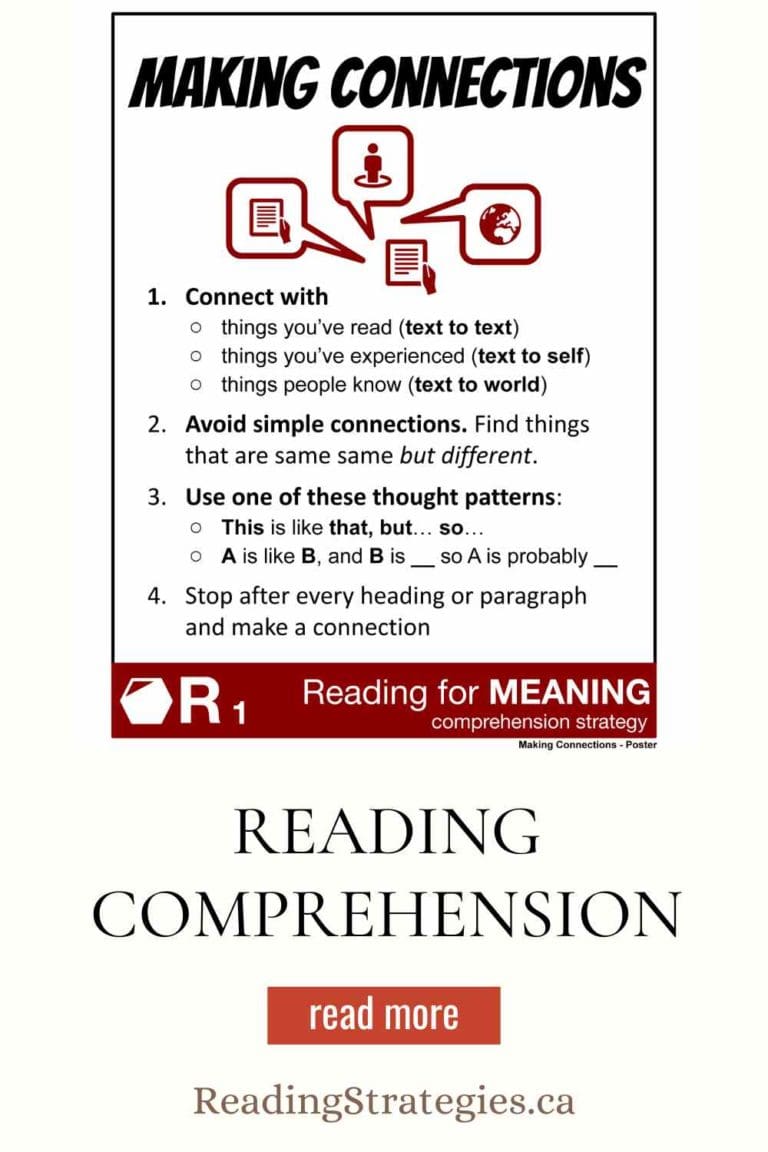
Making Connections Reading Strategy Lesson Plan: How to make deeper Text-to-Self, Text-to-Text, and Text-to-World connections
Making Connections is more than simply finding something that the text reminds you of.
Use this lesson to help your students develop deeper connections instead of thin connections like “this book has a dog and I have a dog…”
How to Make (Deeper) Connections – 4 PRO TIPS:
1. Connect with things you’ve read (text to text), things you’ve experienced (text to self), or things people know (text to world)
2. Avoid simple connections. Find things that are same-same but different.
3. Use one of these thought patterns: “This is like that, but… so…” or “A is like B, and B is _ so A is probably _”
4. Stop after every heading or paragraph and make a connection
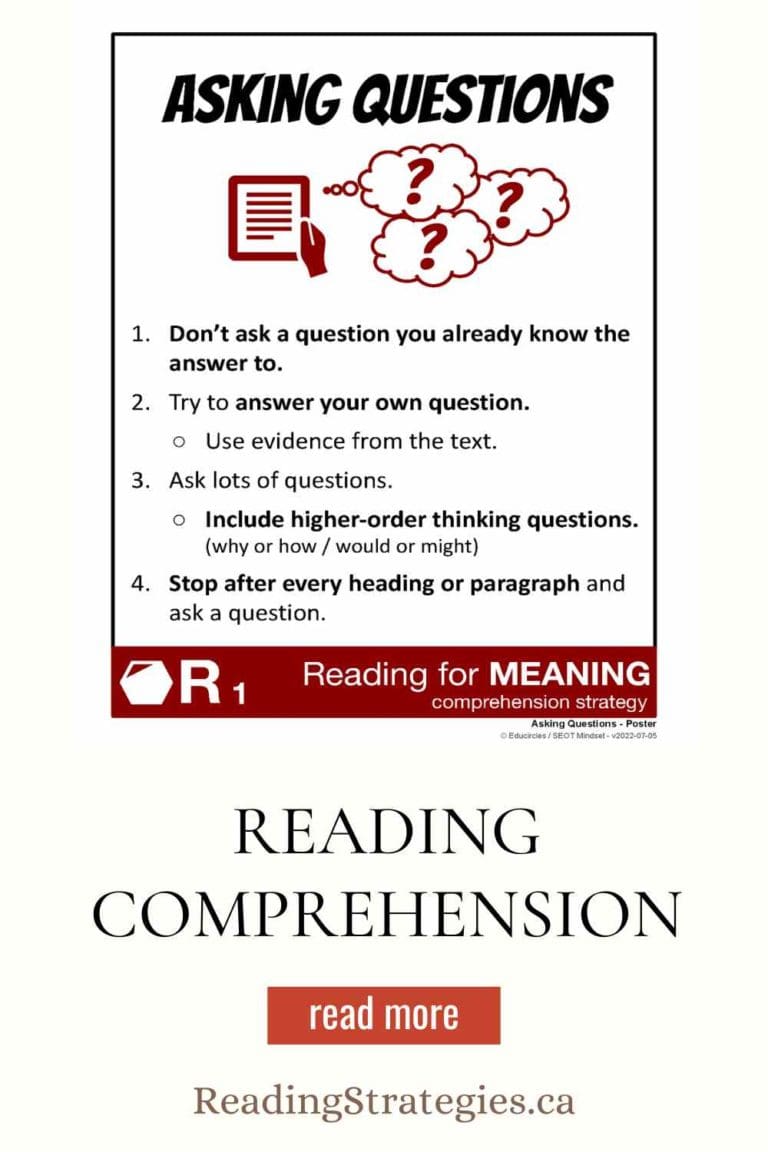
Asking Questions Reading Strategy
Teach 4 PRO TIPS to help students ask the BEST questions when reading to improve comprehension.
High-interest video / slideshow lesson – perfect for your next English Language Arts class.
Students learn how to ask better questions, so they stay engaged while they read.
Active reading strategies can show students how to gain a deeper understanding of the text they’re reading.
How to Ask (Better) Questions – 4 PRO TIPS
1. Don’t ask a question you already know the answer to.
2. Try to answer your own question. Use evidence from the text.
3. Ask lots of questions. Include higher-order thinking questions (why or how / would or might)
4. Stop after every heading or paragraph and ask a question.
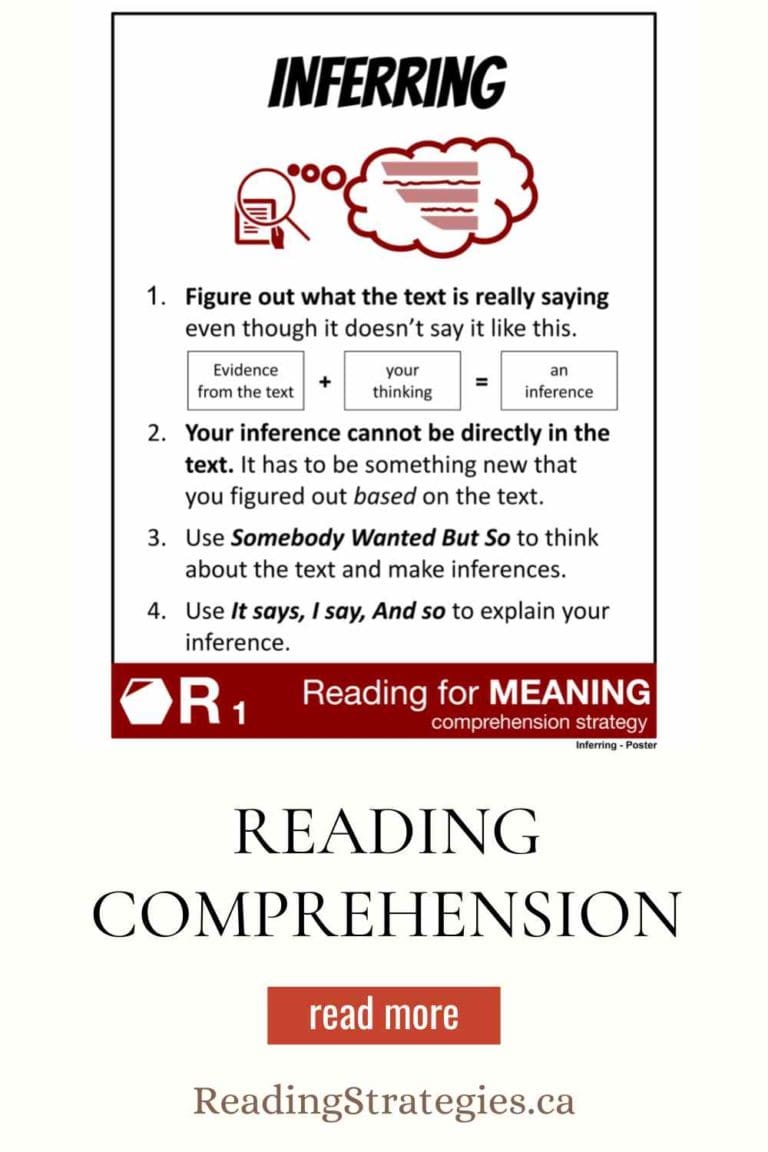
Inferring Reading Strategy Lesson Plan (Inferencing)
Inferring is more than simply reading between the lines.
Use this lesson to help students develop stronger inferences by showing them HOW to come up with an inference, and HOW to check their inference to make it stronger.
How to Infer – 4 PRO TIPS
1. Figure out what the text is really saying even though it doesn’t say it like this. (Evidence from the Text + Your Thinking = an Inference)
2. Your inference cannot be directly in the text. It has to be something new that you figured out based on the text.
3. Use Somebody Wanted But So to think about the text and make inferences.
4. Use It says, I say, And so to explain your inference.
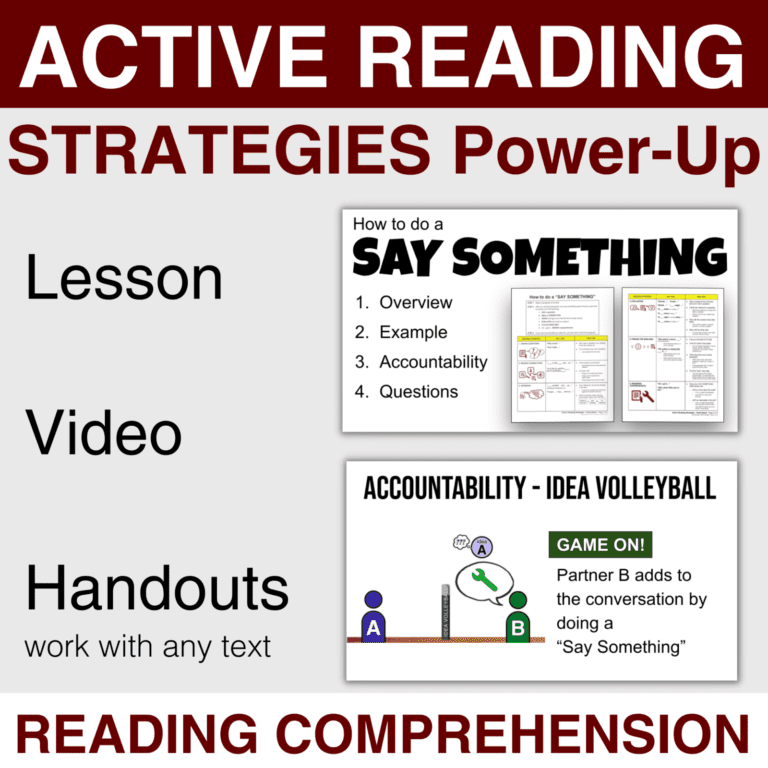
Active Reading Strategies Lesson – Power Up Tool Kit
The Active Reading Strategies Lesson includes strategies and handouts that work with any text! UPDATE: Dec 19, 2022 Improve reading comprehension with just the click of a button! (No, obviously not. But, Evaluating is one of the reading strategies explored in the “Say Something” handout.) FREE until Dec 19, 2022 at 11:59 PM Part 1….
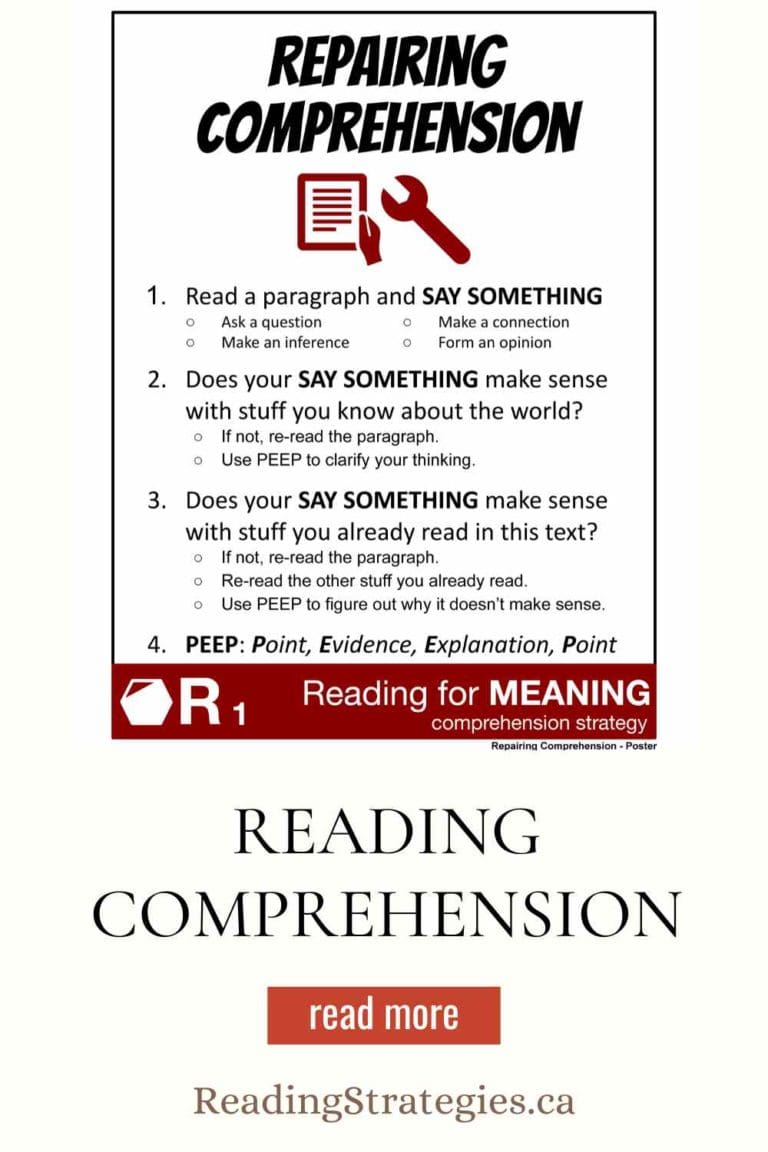
Repairing Comprehension Reading Strategy Lesson Plan
Teach students HOW to monitor understanding and clarify thinking when reading.
There’s more to figuring out what’s going on in a text than just simply re-reading.
4 PRO TIPS: How to Monitor and Repair Comprehension
1. Read a paragraph and SAY SOMETHING: Ask a question, Make a connection, Make an inference, Form an opinion
2. Does your SAY SOMETHING make sense with stuff you know about the world? If not, re-read the paragraph. Use PEEP to clarify your thinking.
3. Does your SAY SOMETHING make sense with stuff you already read in this text? If not, re-read the paragraph. Re-read the other stuff you already read.Use PEEP to figure out why it doesn’t make sense.
4. Use PEEP: Point, Evidence, Explanation, Point
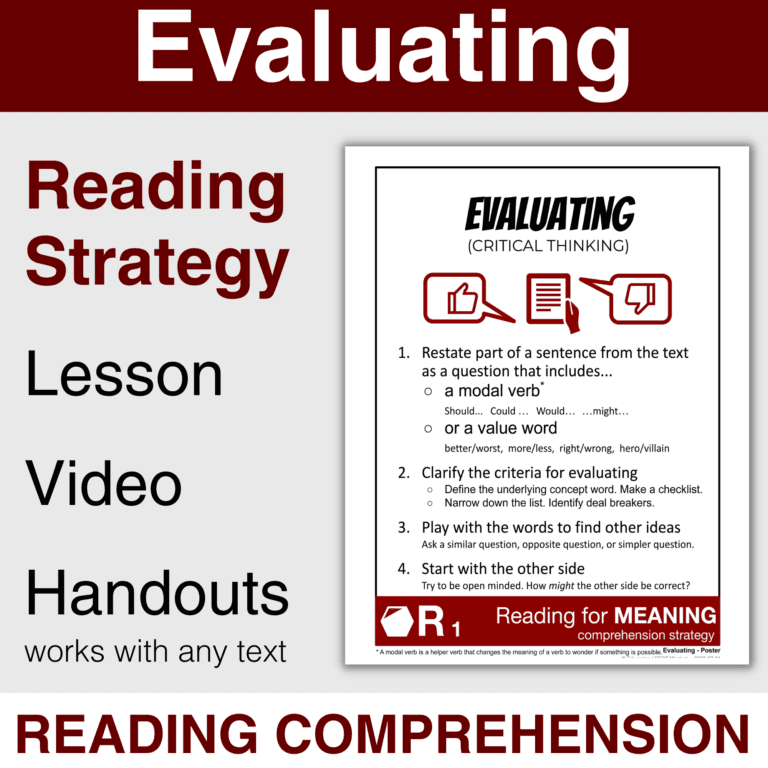
Evaluating Reading Strategy Lesson Plan
Teach students CRITICAL THINKING strategies to help students EVALUATE ideas when reading.
Evaluating is more than just forming an opinion. It’s about making an informed opinion or decision.
Use this lesson to give students a process to help them think critically about the information they read.
4 PRO TIPS to use the Evaluating Reading Strategy:
1. Restate part of a sentence from the text as a question that includes… a modal verb (Should… Could … Would… …might…) or a value word (better/worst, more/less, etc…)
2. Clarify the criteria for evaluating. Define the underlying concept word. Make a checklist. Narrow down the list. Identify deal breakers.
3. Play with the words to find other ideas. Ask a similar question, opposite question, or simpler question.
4. Start with the other side. Try to be open-minded. How might the other side be correct?
Evaluating a Text
Main idea, purpose, & audience.

Text evaluation and analysis usually start with the core elements of that text: main idea, purpose, and audience. An author needs to consider all three of these elements before writing, as they help determine the author’s content and language. As a reader, it’s important to ascertain these aspects of a text which exist as a foundation for the author’s content and language.
Always start with the main idea. Main ideas may be stated directly in the text or implied; you need to read a text carefully in order to determine the main idea. Put the main idea into your own words, so that it’s expressed in a way that makes sense to you. Then ask and answer the following basic questions about that main idea:
- Is the main idea reasonable/believable to most readers?
- Is the main idea clear and if not, why do you think the author embedded it?
- Is the main idea the author’s opinion, or is it something that the author asserts about an issue?
Asking and answering these questions should help you get a sense of the author’s intention in the text, and lead into considering the author’s purpose.
Main idea and purpose are intricately linked. There are a few basic purposes for texts; figuring out the basic purpose leads to more nuanced text analysis based on its purpose. Basic purposes of a text include:
- to inform – to describe, explain, or teach something to your audience
- to persuade/argue – to get your audience to do something, to take a particular action, or to think in a certain way
- to entertain – to provide your audience with insight into a different reality, distraction, and/or enjoyment
The following video more fully explains these different purposes of a text, and adds a fourth, to share insights or feelings.
Main Idea & Purpose Determine Analysis
The author’s main idea and purpose in writing a text determine whether you need to analyze and evaluate the text. They also determine the pieces of the text you should analyze—content or language or both.
If the purpose is to persuade or argue
You always need to analyze the text to see if the main idea is justified. Do the supporting ideas relate to and develop the main idea? Is the supporting evidence taken from recognized, valid sources? Is the author arguing via language instead of evidence or facts? Persuasion and argument need to present logically valid information to make the reader agree intellectually (not emotionally) with the main idea.
If the purpose is to inform
You usually need to analyze the text, since the text needs to present valid information in as objective a way as possible, in order to meet its purpose of explaining concepts so a reader understands.
If the purpose is to entertain
You may or may not need to analyze the text. Writing that entertains does not necessarily have to be either logical or complete in order to accomplish its purpose. You may want to analyze the text for language, though, to see how the author manipulates language to accomplish their purpose.

Who are the author’s intended readers? Figuring out this will help you understand an author’s approach to providing the main idea with a particular purpose. Does the audience know little or nothing about the topic, or are they already knowledgeable? Is the audience’s knowledge at beginner or expert level, somewhere in between, or mixed? Does the audience include people who may be skeptical of the author’s ideas? Does the audience include people who outright oppose the author’s ideas? As you can see, asking and answering questions about audience can help an author determine the type and amount of content to include in a text. As a reader, it’s important to figure out the author’s intended audience, to help you analyze the type, amount, and appropriateness of the text’s information.
The following video presents the concept of audience from a writer’s perspective, but the concepts are applicable to you as a reader who needs to consider audience as a foundation for evaluating a text.
You may also want to link to one of Purdue’s Online Writing Lab’s page on Author and Audience to get a sense of the wide array of variables that can influence an author’s purpose, and that an author may consider about an audience.
Read the article “ Forget Shorter Showers ” by Derrick Jensen.
Note that most of the Try It exercises in this section of the text will be based on this article, so you should read carefully, annotate, take notes, and apply appropriate strategies for reading to understand a text.
Then answer the following questions about the article’s main idea, purpose, and audience.
Which selection best represents the author’s main idea?
- We have it in our power and right to take action to stop the industrial economy over-using and wasting our natural resources.
- We are victims of a campaign of misdirection, being told and accepting that our personal use of natural resources is both the cause of scarcity and the solution to preservation.
- Because we have accepted our identities as consumers, we reduce our forms of political existence to consuming and not consuming.
- Simple living is better for the planet than over-consumption.
Sentence 1 is the best answer. Although sentences 2 and 3 extract main ideas from the text, they are key supporting points that help lead to the author’s conclusion and main idea.
Which selection best represents the author’s purpose?
- to inform readers about the actual use of resources by individuals vs. the industrial economy
- to persuade readers to consider taking action against an unjust situation that assigns blame to individuals instead of big business in regard to the depletion of natural resources
- to persuade readers to re-think their personal attempts to live more simply and more “green”
- to entertain readers interested in nature with accusations against the industrial economy
Selection 2 best represents the author’s purpose. The author’s purpose is to get readers thinking about conservation of resources in order to spur them to action against a system that, in his opinion, exploits those resources as well as individuals. His purpose is both to inform and persuade, but persuasion seems to take precedence, as he both starts and ends with a reminder about historically justified instances of activism.
Who comprises the author’s audience and what cues can you use to determine that audience?
The author is writing to an audience of readers who are interested in nature and conservation. If you look on the Orion website and read the “About” section on Mission and History, you’ll see that this publication started as a magazine about nature and grew from there. Based on reading the text, the author’s intended audience has the following characteristics:
- Educated – The author assumes that readers know about WWII, the Civil Rights Act of 1974, and other historic events. The author also uses language such as “systematic misdirection,” “solar photovoltaics,” and even “consensus” (instead of agreement).
- Concerned about the environment – because they are reading this magazine in the first place
- Willing to entertain the idea of taking action to improve quality of life and preserve resources
- Comfortable enough (with themselves? with their social status? with their personal philosophies?) to feel that their voices might make a difference if they choose to protest the current use of natural resources
- Purpose & Audience. Authored by : Susan Oaks. Project : Introduction to College Reading & Writing. License : CC BY-NC: Attribution-NonCommercial
- video The Author's Purpose. Authored by : Marc Franco. Provided by : Snap Language. Located at : https://www.youtube.com/watch?v=z6H2NLPqWtI . License : Other . License Terms : YouTube video
- video Audience: Introduction & Overview. Authored by : Gracemarie Mike and Daniel Liddle. Provided by : The Purdue Online Writing Lab. Located at : https://www.youtube.com/watch?v=4_ypxLRYsrE . License : Other . License Terms : YouTube video
- image of woman with a stack of books instead of a head, facing shelves of books. Authored by : Gerd Altmann. Provided by : Pixabay. Located at : https://pixabay.com/photos/books-question-mark-student-stack-4158244/ . License : CC0: No Rights Reserved
- image of the word Evaluation. Authored by : Gerd Altmann. Provided by : Pixabay. Located at : https://pixabay.com/illustrations/district-evaluation-assessment-1264717/ . License : CC0: No Rights Reserved

Privacy Policy
- Skip to main content
Stellar Teaching Co.
Engaging Resources for Teaching Literacy
By Sara Marye Leave a Comment
How to Find the Main Idea: 7 Strategies That Work
If you are an upper elementary reading teacher, I bet you have to teach your students how to find the main idea of a nonfiction text… more than likely that is one of your state standards, and also something that is included on the end of year reading assessment.
But, it’s also a really important reading skill that we want our students to know how to do.
When we identify the main idea of the text, we are able to figure out the important idea or concept in the text. This skill will help us remember what we read as well as build up our background knowledge for the topics that we are learning about.
If your students struggle to identify the main idea, or if you are getting ready to introduce it for the first time to your students, here are 7 different strategies you can teach your students to help them identify the main idea.
7 Strategies to Help Students Learn How to Find the Main Idea of Nonfiction Texts
1. question the topic .
This is a super simple strategy and can usually help the students discover the main idea of a text… and understand the connection between main idea and author’s purpose.
First, have students identify the topic of the text. This is usually a single word or phrase.
Then have students ask the question “What does the author want me to know about this topic?”
Usually, this answer will help them figure out the main idea… They start to realize that most texts have a specific topic they are focusing on, but the main idea of the text is closely connected to why the author wrote the text. The author wants the reader to know or understand something specific and that is usually the main idea.
Asking the question “What does the author want me to know about this topic?” can usually help students identify the main idea of the text.
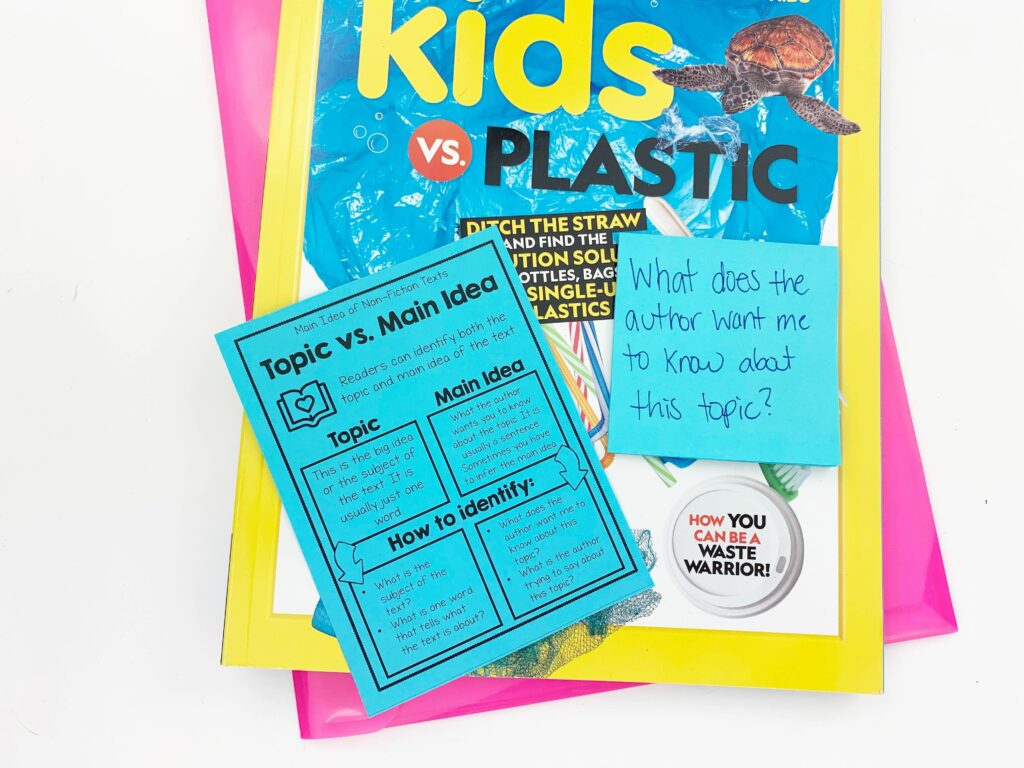
2. Identify Topic Sentence
A topic sentence is the sentence that will state the main idea for that specific paragraph. This means that if students know what a topic sentence is and they know how to identify it, they can identify a clue that will help them figure out the main idea.
If students are identifying the main idea of a paragraph or a small section, they can just look for the topic sentence and then re-write it so it clearly states the main idea.
If the students are identifying the main idea of an entire text, they can find the topic sentences for each small paragraph or section and then synthesize that information to create a topic sentence for the entire text.
This can be a pretty straightforward strategy, but you have to use it with caution. Students are often taught that the topic sentence is the first sentence of a paragraph. And it often can be… but it isn’t always. It’s important for students to understand what a topic sentence is rather than just immediately look at the first sentence and assume it states the main idea of the paragraph.
But if your students get really good at being able to identify the topic sentence, then they have a strategy that will help them focus on the main idea of the text.
3. Use Headings/Subheadings
One way you can teach your students to identify the main idea is to have them use the headings or subheadings in the text. This can be particularly helpful if they are reading a lengthy article or a book with lots of chapters/sections.
Hopefully, your students know and understand that headings can give them clues about what a particular section of text will be about. If they know that a heading will give them clues to the main idea of a specific text section, they can synthesize the information shared in the headings to help them come up with the main idea for the entire text.
4. Look for repeated words or phrases
If it’s important it will get repeated! Think about how many times you tell your students to put their name on the paper or to double-check their work. We naturally repeat words or phrases that are important and the same thing happens in the texts that we read.
You can teach your students to look for keywords and phrases that get repeated in the text. They can either underline them or make a list of them on the side of the text. If they notice a word or phrase gets repeated over and over and over in a particular article or text, it’s probably a clue that it’s important to the topic and should probably be included in the main idea.
5. Consider the title
This strategy could work in two different ways.
First, you can teach students to look at the title and think about how the title communicates what the text will mostly be about. Basically, we are teaching them that a title can be a clue or a hint to the reader that shares a preview of what the text might be about. Often times the title includes the topic or a keyword or phrase that can be connected to the main idea.
You can also teach your students to come up with their own title. You can either have students cover up the title for the text, or you can remove it for them. Ask them to think about a title they would give the text. When students think about what title they would give the text, they start to think about what the text is mostly about… which is the main idea.
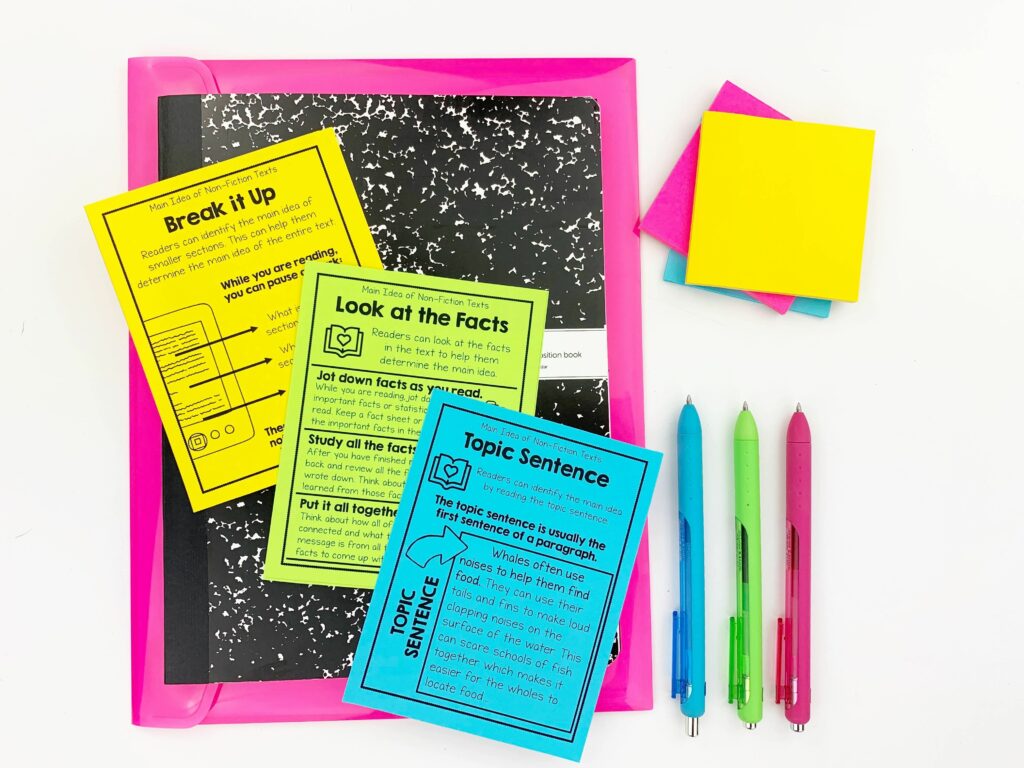
6. Keep a list of facts
I love teaching my students to stop-and-jot while they read. This simply means that they are jotting down their questions, connections, or thoughts about the text.
When they are reading nonfiction text, I like to have them make a list of key facts. This can be as simple as making a bulleted list of key facts while they are reading. When students have finished reading, they can quickly look over their key facts. Seeing JUST the facts can help them focus on the important details related to the text and it can help them identify the main idea of the text.
7. Break up the text into smaller sections
This is a great strategy to teach students if you want them to identify the main idea of a longer text. One thing you can do is teach your students to break up the text into smaller sections and then pause at the end of each section and ask “What is this section about?”
This helps students identify the main idea of smaller sections rather than having to wait until the very end to think about the main idea of the text.
I like to have students jot down their notes about each section on a post-it note or in the margins of the text. Then, once they have finished, they can go back and re-read their notes. Looking at JUST the notes will help them think about the main idea of the text, rather than relying on their memories alone.
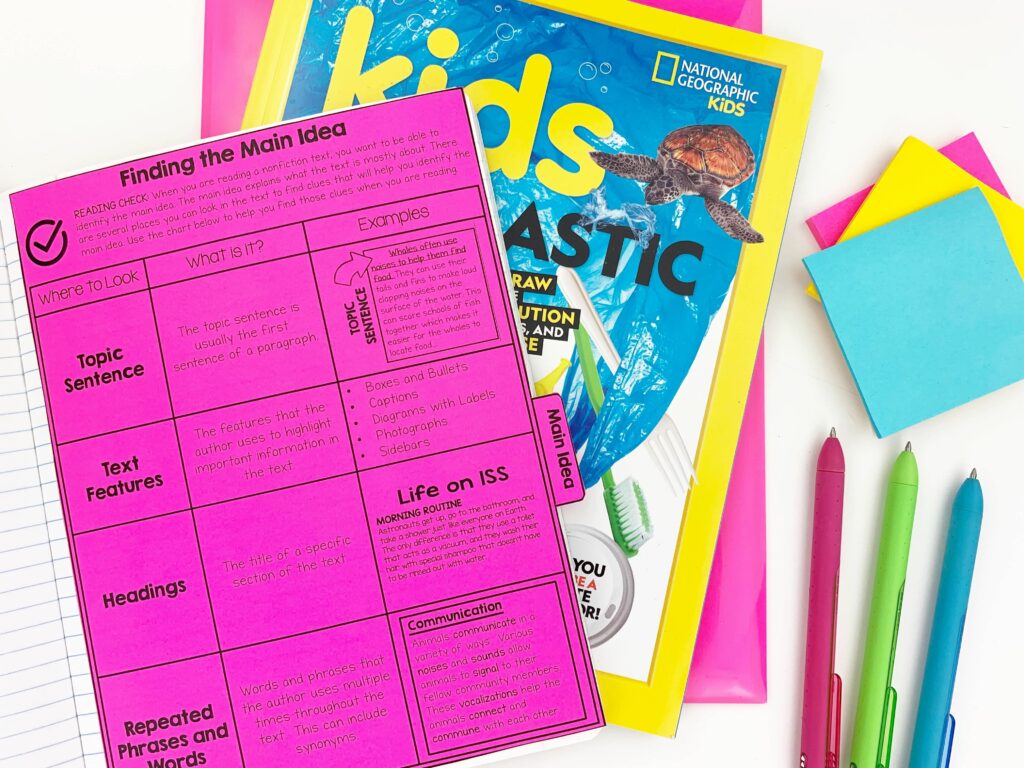
Which strategies should I teach my students?
Now you definitely don’t need to teach all seven strategies to your students, but you might want to teach them 3-4 different strategies. I always like teaching students more than one strategy for any given reading skill.
Teaching multiple strategies can be helpful for a few reasons:
- Not every strategy will work with every text.
- Not every strategy will resonate with every student.
- It can be helpful to have multiple strategies to use as a self-check to confirm our thinking.
Hopefully, you feel a little more excited and confident in your ability to teach main idea to your students…I can’t wait to hear which strategies you decide to incorporate into your reading block.
Happy Teaching!
Summarizing Nonfiction Checklist
Summarizing nonfiction can be really challenging. There are SOOOOO many things your students need to be able to do in order to successfully summarize a nonfiction text. But, with the help of this checklist, your students will remember the important characteristics of a nonfiction summary.
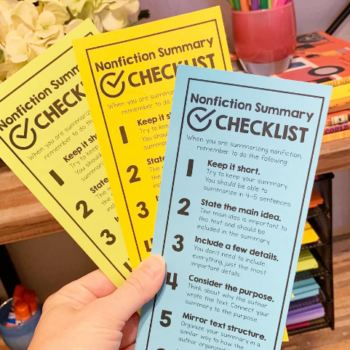

Check out these products on TPT!
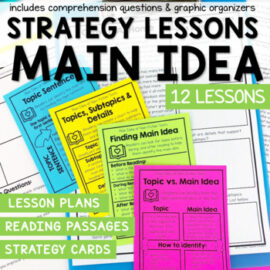
Want Even More?
You’ll love these related posts!
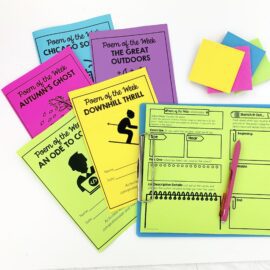
Reader Interactions
Leave a comment cancel reply.
You must be logged in to post a comment.
Grab Your FREE Gift!
Word Of The Day: Context Clue Routine
With this freebie, you'll get everything you need to get started with word of the day in your classroom. You'll get all the student and teacher materials for five days. Word of the day will help your students become experts at using context clues.
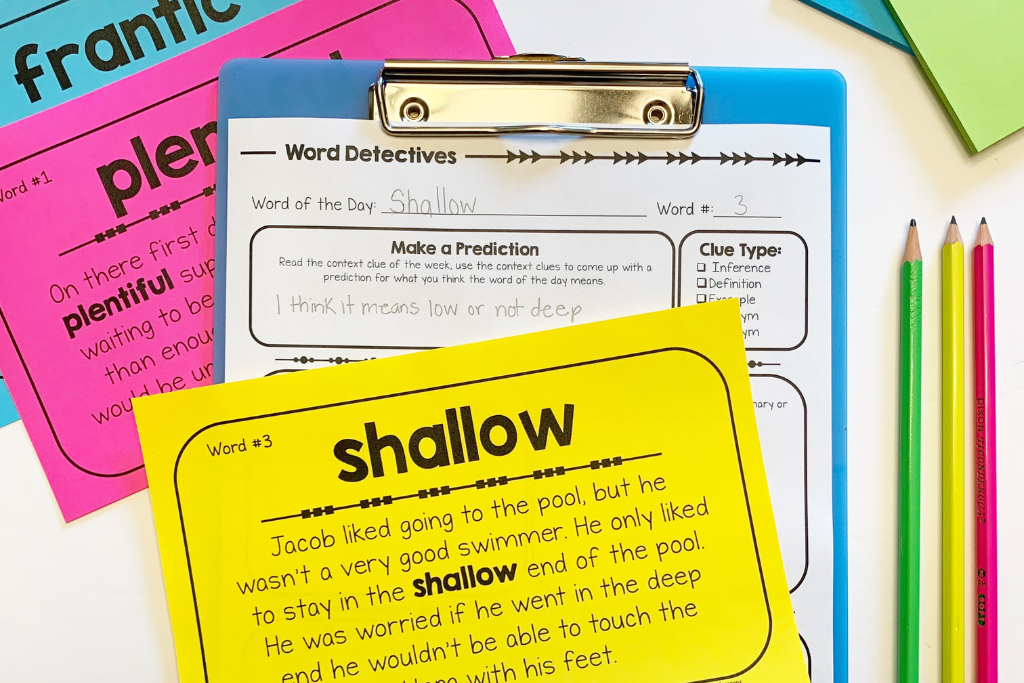
Stellar Teacher Podcast
SUBSCRIBE & LISTEN HERE
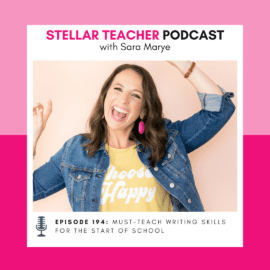
Must-Teach Writing Skills for the Start of School
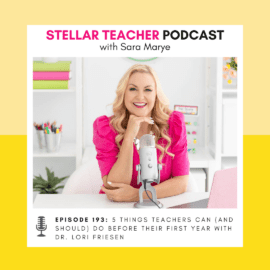
5 Things Teachers Can (And Should) Do Before Their First Year With Dr. Lori Friesen
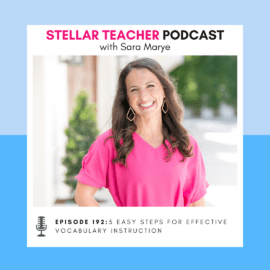
5 Easy Steps for Effective Vocabulary Instruction
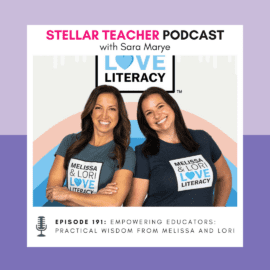
Empowering Educators: Practical Wisdom From Melissa and Lori

Free private podcast!
The Confident Writer System Series
In less than 90 minutes, you'll learn quick and easy ways that will transform your upper elementary student's writing.
Join our membership!
The Stellar Literacy Collective
You didn’t become a teacher to spend your rare free time scrolling Pinterest and searching on Google. Trust me friend, I have been there. That’s why this membership was created. When you join, you receive countless pre-planned resources without sacrificing engagement, rigor, and effectiveness. That means less planning and more teaching. Beyond the resources, you’ll gain a community of like-minded teachers. Are you ready to level up your instruction and maybe even find a new teacher bestie?
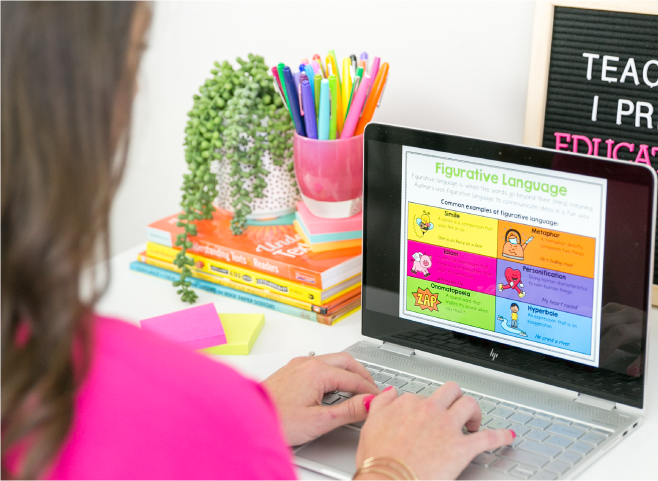
Follow Me Here
I’m Sara, your literacy lovin’ mentor and cheerleader.
With over a decade of experience working as a classroom teacher and school administrator, I understand the joys and challenges of teaching. That’s why I’m on a mission to make an impact by serving stellar upper elementary teachers just like you. Get ready, because I’m pulling out all the stops to ensure that you have the tools and confidence you need to build a literacy block that you’re proud of. One that excites you and your students while also meeting the standards. Oh yes, it’s totally possible to have both!
Identifying Main Ideas
A main idea is the most important thought on your topic. So let’s get into how to spot, and create, a really good one!
Explicit Main Idea
A main idea is the author’s controlling point about the topic. It usually includes the topic and the author’s attitude or opinion about the topic. To identify the main idea, ask yourself:
- Who or what is the paragraph about? The answer is the topic . The topic can be stated in just a few words.
- What does the author think about the topic? The answer is the point. The point can also be stated in just a few words.
Once you’ve identified these pieces, you can combine them to state the author’s main idea in a single sentence.
Topic + Point = Main Idea
Topic = the cool-down period
Point = important parts of exercise workouts
( Topic + Point = Main Idea )
The cool-down period is an important part of an exercise workout .
Placement of Main Ideas & Topic Sentences
Often, but not always, the main idea of a paragraph is written as that paragraph’s topic sentence . A topic sentence is a single sentence that states the topic and words that qualify the topic by revealing the author’s opinion about the topic or the author’s approach to the topic and also reveal the author’s thought pattern or organizational strategy. When you’ve identified both the main idea and the thought pattern, you can identify the topic sentence.
Main Idea = The cool-down period is an important part of an exercise workout
Thought Pattern = several reasons
The cool-down period is an important part of an exercise workout for several reasons .
Main Idea + Thought Pattern = Topic Sentence
Below are more examples of how to craft topic sentences.
General to Specific
The topic sentence is the one sentence that is general enough to include all the ideas in the paragraph. Therefore, a topic sentence that begins a paragraph or appears within the first few sentences of a paragraph signals a move from general ideas to specific ideas.
Specific to General to Specific
At times, an author begins a paragraph with details to stir the reader’s interest in the topic. The flow of ideas moves from the specific to the general and back to the specific.
Specific to General
Sometimes, an author waits until the end of the paragraph to state the topic sentence and main idea. This allows the details to build up to the main idea and is sometimes called “climactic order.”
Implicit Main Idea
Implicit main idea refers to a main idea that is not stated directly but is strongly suggested by the supporting details in the passage. Many paragraphs in college textbooks do not provide a topic sentence, instead using supporting details to imply the main idea. To determine the implied main idea, look at:
- The supporting details: facts, examples, descriptions, and explanations given
- The author’s thought pattern
- The author’s purpose
Read the sample paragraph below:
Egypt’s pyramids are the oldest existing buildings in the world. These ancient tombs are also among the world’s largest structures. The largest pyramid stands taller than a 40-story building and covers an area greater than that of ten football fields. More than 80 pyramids still exist, and their once-smooth limestone surfaces hide secret passageways and rooms. The pyramids of ancient Egypt served a vital purpose: to protect the pharaoh’s bodies after death. Each pyramid held not only the pharaoh’s preserved body, but also all the goods he would need in his life after death.
1.The topic of the paragraph is pyramids
2. There are three groups of supporting details: age, size, and purpose
3.The author has organized the supporting details into “characteristics” or “traits” of the pyramids.
4.The author purpose seems to be trying to define a pyramid.
Implied Main Idea: Pyramids are structures with several distinctive traits.
Remember, the main idea must be broad enough to cover all the details in the paragraph without being so broad that it includes details not mentioned.
Michael|2019
This work is licensed under the Creative Commons Attribution-NonCommercial-ShareAlike 4.0 International License. To view a copy of this license, visit http://creativecommons.org/licenses/by-nc-sa/4.0/.
How To Find The “Main Idea” Of A Text
The main idea , sometimes referred to as the central idea, is the most important thought of a text. From elementary school on up, we’re taught to discuss and analyze pieces of writing in terms of the main idea . Knowing how to identity the main idea in a piece can help us become better readers—and writers.
What is a main idea?
The majority of details in a text reference the main idea . Basically, it’s the topic that comes up over and over again in an article, book, or other piece of nonfiction. The term main idea is generally associated with informational, nonfiction texts like newspaper articles.
The main idea tells the reader what the paragraph, article, or other section of a text is going to be about. Often the main idea is explicitly provided in a declarative statement, which is a statement of fact ending in a period:
Every year, hundreds of children prepare to compete in the Scripps Spelling Bee. Along with their family members, these would-be competitors memorize thousands of dictionary entries. They are hoping to win as much as $52,000. Of course, they are also hoping for bragging rights!
Every sentence in this paragraph is about the hundreds of children who compete in the Scripps Spelling Bee . The main idea is explicitly stated in the first sentence of the paragraph. The following sentences give specific details about these contestants—how they prepare and what they hope to win.
Here’s another example in which the main idea is explicitly stated in the paragraph. In this case, though, the main idea is stated at the end of the paragraph instead of the beginning:
There is a ceaseless murmur of people practicing tricky words. Contestants pace the hallway with their parents. A voice comes over the loudspeaker announcing that there are 10 minutes until the start, causing a ripple of excitement to go out. It is the first day of the Scripps Spelling Bee and the tension is electric.
Every sentence in the paragraph describes a detail about the morning of the first day of the Scripps Spelling Bee. The details give a sense of how tense the morning is. That’s how we know that the last sentence of the paragraph, It is the first day of the Scripps Spelling Bee and the tension is electric , is the main idea of the paragraph.
But what if the main idea is not so obvious?
Sometimes, the main idea is shown implicitly . In those cases, you have to find the main idea by determining what the majority of details in the paragraph or section are about. For example:
The first step to making a pie is to make the dough. While the dough is chilling, you can make your filling. Next, roll out the dough and bake it a little bit. Finally, add the filling and bake your pie.
None of these sentences say explicitly what the main idea is. However, every single sentence is about how to make a pie . That is the main idea of this paragraph.
Just like paragraphs have main ideas , paragraphs build to make the main idea of an article. Sometimes, the main idea of an article is stated in the first or second paragraph. Often, it’s implicit, meaning a majority of the paragraphs are about a particular topic.
Knowing the main idea is important for writing a summary of a text. A good summary of a nonfiction text includes the main idea , as well as the major contributing details:
The article is about the annual competitive spelling bee in the United States. First, the organizers are profiled. Then, the article details the lives of the children who are preparing to enter the spelling bee and the people who live with them. Finally, we learn what the day of the competition itself is like.
What is a theme?
While finding the main idea of a text is typically associated with informational, nonfiction texts, there are associated concepts for argumentative texts and fictional texts. When reading an argumentative text, you might be looking for the main argument . For a fictional text, you might be looking for a theme .
The process for finding the main idea , the main argument , or theme of a text is roughly the same. You have to pay attention to what a majority of details in a paragraph or the majority of paragraphs in an article are about. Sometimes, this is given explicitly.
Often, you have to read between the lines to figure it out. There’s no novel that just states, “the theme of this novel is how to overcome hardships.” Instead, the protagonist learns to face their fear of spelling with lots of practice throughout the story. That’s how we know that overcoming hardship is the theme shown in the story.
Whether the main idea is implicit or explicit, expect to see questions about main ideas when it comes to reading informational texts in school. These questions are asking you to look for what the majority of details in the paragraph or section of text are all about.
Once you know what you’re looking for, finding the main idea becomes a lot easier. After all, it is the core of what the author is trying to tell you—the reader—about.
Want more fun word activities and more tips to help with your kids’ homework? Sign up for Dictionary.com right in your inbox!

Ways To Say
Synonym of the day
popular searches
- Request Info
Finding the Main Idea
The main idea of a paragraph is the author's message about the topic. It is often expressed directly or it can be implied. Knowing how to find main ideas allows you to understand and think critically about what you're reading. And that benefits you regardless of your chosen profession.
Where Are The Main Ideas Found?
It is easy to identify a main idea that is directly expressed in the text. Main ideas are often found:
- at the beginning of paragraphs. The first sentence often explains the subject being discussed in the passage.
- in the concluding sentences of a paragraph. The main idea can be expressed as a summation of the information in the paragraph as well as a link to the information in the next paragraph.
The main idea is not always clearly stated. It is more difficult to identify a main idea when it is inferred or implied. It can be implied through other words in the paragraph. An implied main idea can be found in several ways.
- Several sentences in a paragraph can imply the main idea by introducing facts about the topic before actually stating the topic.
- Implied ideas can be drawn from facts, reasons, or examples that give hints or suggestions concerning the main idea. These hints will be clues leading you to discover the main idea in the selected text.
- Try the passage below to see if you can pick out the main idea. "To many parents, the infant's crying may be mainly an irritation, especially if it continues for long periods. But crying serves important functions for the child as well as for the parents. For the child, crying helps improve lung capacity and the respiratory system. Perhaps more important, the cry serves as a signal of distress. When babies cry, they indicate that they are hungry or in pain, and this is important information for parents."
Use the hints below to determine the correct main idea of this paragraph.
After reading a paragraph ask, "What point is the author making in this passage?"
Ask the following questions:
- Who - Does this passage discuss a person or group of people?
- When - Does the information contain a reference to time?
- Where - Does the text name a place?
- Why - Do you find a reason or explanation for something that happened?
- How - Does this information indicate a method or a theory?
How To Determine If I Have Selected the Correct Main Idea of a Paragraph?
If you are able to summarize the information in the passage in your own words,you have absorbed the correct main idea. To accomplish this goal, try the steps listed below after reading a short section of your textbook.
- Write a short summary in your own words about what you have read.
- Does your summary agree with this general topic?
- Does your summary contain the same ideas being expressed by the author?
- Could you write a headline (or textbook subheading) that would express your summary in less than five words?
If you are able to rephrase your choice of a topic sentence into a question and then determine if the passage answers your question, you have been successful at selecting a main idea.
Other Writing Resources
Enhance your academic writing skills by exploring our additional writing resources that will help you craft compelling essays, research papers, and more.

Your New Chapter Starts Wherever You Are
The support you need and education you deserve, no matter where life leads.
because a future built by you is a future built for you.
Too many people have been made to feel that higher education isn’t a place for them— that it is someone else’s dream. But we change all that. With individualized attention and ongoing support, we help you write a new story for the future where you play the starring role.

- school Campus Bookshelves
- menu_book Bookshelves
- perm_media Learning Objects
- login Login
- how_to_reg Request Instructor Account
- hub Instructor Commons
Margin Size
- Download Page (PDF)
- Download Full Book (PDF)
- Periodic Table
- Physics Constants
- Scientific Calculator
- Reference & Cite
- Tools expand_more
- Readability
selected template will load here
This action is not available.

3.8: Main Ideas and Supporting Details
- Last updated
- Save as PDF
- Page ID 31307

- Athena Kashyap & Erika Dyquisto
- City College of San Francisco via ASCCC Open Educational Resources Initiative
\( \newcommand{\vecs}[1]{\overset { \scriptstyle \rightharpoonup} {\mathbf{#1}} } \)
\( \newcommand{\vecd}[1]{\overset{-\!-\!\rightharpoonup}{\vphantom{a}\smash {#1}}} \)
\( \newcommand{\id}{\mathrm{id}}\) \( \newcommand{\Span}{\mathrm{span}}\)
( \newcommand{\kernel}{\mathrm{null}\,}\) \( \newcommand{\range}{\mathrm{range}\,}\)
\( \newcommand{\RealPart}{\mathrm{Re}}\) \( \newcommand{\ImaginaryPart}{\mathrm{Im}}\)
\( \newcommand{\Argument}{\mathrm{Arg}}\) \( \newcommand{\norm}[1]{\| #1 \|}\)
\( \newcommand{\inner}[2]{\langle #1, #2 \rangle}\)
\( \newcommand{\Span}{\mathrm{span}}\)
\( \newcommand{\id}{\mathrm{id}}\)
\( \newcommand{\kernel}{\mathrm{null}\,}\)
\( \newcommand{\range}{\mathrm{range}\,}\)
\( \newcommand{\RealPart}{\mathrm{Re}}\)
\( \newcommand{\ImaginaryPart}{\mathrm{Im}}\)
\( \newcommand{\Argument}{\mathrm{Arg}}\)
\( \newcommand{\norm}[1]{\| #1 \|}\)
\( \newcommand{\Span}{\mathrm{span}}\) \( \newcommand{\AA}{\unicode[.8,0]{x212B}}\)
\( \newcommand{\vectorA}[1]{\vec{#1}} % arrow\)
\( \newcommand{\vectorAt}[1]{\vec{\text{#1}}} % arrow\)
\( \newcommand{\vectorB}[1]{\overset { \scriptstyle \rightharpoonup} {\mathbf{#1}} } \)
\( \newcommand{\vectorC}[1]{\textbf{#1}} \)
\( \newcommand{\vectorD}[1]{\overrightarrow{#1}} \)
\( \newcommand{\vectorDt}[1]{\overrightarrow{\text{#1}}} \)
\( \newcommand{\vectE}[1]{\overset{-\!-\!\rightharpoonup}{\vphantom{a}\smash{\mathbf {#1}}}} \)
Analyze Thesis or Main Ideas of Texts
Being able to identify the purpose and thesis of a text, while you’re reading it, takes practice. Questioning the text you’re reading is a good place to start. When trying to isolate the thesis, or main idea, of your reading material, consider these questions:
- What is the primary subject of this text?
- Is the author trying to inform me, or persuade me?
- What does the author think I need to know about this subject?
- Why does the author think I need to know about this subject?
Sometimes the answer to these questions will be very clearly stated in the text itself. Sometimes it is less obvious, and in those cases, the techniques on the following page will be useful.
Implicit vs. Explicit Main Idea/ Thesis Statements
According to author Pavel Zemliansky,
Arguments then, can be explicit and implicit, or implied. Explicit arguments contain noticeable and definable thesis statements and lots of specific proofs. Implicit arguments, on the other hand, work by weaving together facts and narratives, logic and emotion, personal experiences and statistics. Unlike explicit arguments, implicit ones do not have a one-sentence thesis statement. Instead, authors of implicit arguments use evidence of many different kinds in effective and creative ways to build and convey their point of view to their audience. Research is essential for creative effective arguments of both kinds.
Even if what you’re reading is an informative text, rather than an argumentative one, it might still rely on an implicit thesis statement. It might ask you to piece together the overall purpose of the text based on a series of content along the way.
The following video defines the key terms explicit and implicit, as they relate to thesis statements and other ideas present in what you read. It also introduces the excellent idea of the reading voice and the thinking voice that strong readers use as they work through a text.
To help keep you on your toes, the author of this video challenges you to find her spelling mistake in one of her cards along the way!
Explicit v. implicit . Authored by: Michele Armentrout. All Rights Reserved. License Terms: Standard YouTube license.
Take the quiz about implicit and explicit thesis statements to see how well you have understood the information.
Thesis and Topic Sentences
You’ll remember that the first step of the reading process, previewing, allows you to get a big-picture view of the document you’re reading. This way, you can begin to understand the structure of the overall text. A later step in the reading process, summarizing , allows you to encapsulate what a paragraph, section, or the whole document is about. When summarizing individual paragraphs, it’s likely that your summary ends up looking like a paraphrase of that paragraph’s topic sentence .
A paragraph is composed of multiple sentences focused on a single, clearly-defined topic. There should be exactly one main idea per paragraph, so whenever an author moves on to a new idea, he or she will start a new paragraph. For example, this paragraph defines what a paragraph is, and now we will start a new paragraph to deal with a new idea: how a paragraph is structured.
Paragraphs are actually organized much like persuasive papers are. Just like a paper has a thesis statement followed by a body of supportive evidence, paragraphs have a topic sentence followed by several sentences of support or explanation. If you look at this paragraph, for example, you will see that it starts with a clear topic sentence letting you know that paragraphs follow a structure similar to that of papers. The next sentence explains how a paragraph is like a paper, and then two more sentences show how this paragraph follows that structure. All of these sentences are clearly connected to the main idea.
The topic sentence of a paragraph serves two purposes: first, it lets readers know what the paragraph is going to be about; second, it highlights the connection between the present paragraph and the one that came before. The topic sentence of this paragraph explains to a reader what a topic sentence does, fulfilling the first function. It also tells you that this paragraph is going to talk about one particular aspect of the previous paragraph’s main idea: we are now moving from the general structure of the paragraph to the particular role of the topic sentence.
After the topic sentence introduces the main idea, the remainder of the sentences in a paragraph should support or explain this topic. These additional sentences might detail the author’s position on the topic. They might also provide examples, statistics, or other evidence to support that position. At the end of the paragraph, the author may include some sort of conclusion or a transition that sets up the next idea he or she will be discussing (for example, you can see this clearly in the last sentence of the third paragraph).
The Three Parts of a Paragraph
The topic is the subject of the paragraph. It can be:
- A few words long
- These words (or words related to the topic) are typically repeated throughout the paragraph
- Answers the question: What is this paragraph about?
2) Main Idea
This is the writer’s overall point. It can be:
- If stated in the paragraph, it’s called a “topic sentence”
- If unstated in the paragraph, the reader must figure it out (infer it) from details
- General enough to cover the more specific supporting details
- Usually (but not always!) near the beginning of the paragraph
- Answers the question: What is the overall point being made about the topic?”
3) Supporting Details
These are the details in the paragraph that support the main idea. They can be either major or minor supporting details.
Tips for Identifying Main Ideas
Although you are learning to put the main idea first in your own paragraphs, professional writers often don’t. Sometimes the first sentence of a paragraph provides background information, poses a question, or serves as a bridge from a previous paragraph. Don’t assume it is the main idea. Use these tips instead:
- Look for a general statement that appears to “cover” the other information.
- Figure out the general topic of the paragraph first. Then ask yourself, “What point is the writer trying to make about this topic?”
- Look for clue words. Main ideas sometimes have words such as “some” or plural nouns like “ways” or “differences” that signal a list of details to come.
- Is this statement supported by most of the other information?
- If I turn this statement into a question, does the other information answer it?
SPECIAL NOTE: Sometimes a main idea covers more than one paragraph. This may happen in newspaper articles or when the writer has a lot to say about one topic.
Difference Between the Topic and Main Idea
To understand the difference between a main idea and the topic, imagine that you are listening to your friends talk about their pets. The TV is on, so all you can make out are the name of their pets. If someone asked you what the topic was, you would say “pets.” But because you couldn’t hear the whole thing, you didn’t understand the “main idea” was whose pet was the best. The topic is very broad – the main idea is more specific. The sentences that follow in the paragraph exercise offer examples or descriptions to illustrate or explain the main idea. Note the reading-writing connection--while we are finding the main idea as readers, we will be using the main ideas to write topic sentences in paragraphs.
Exercise \(\PageIndex{1}\)
Read the following paragraph and then decide what the main idea is.
One myth about exercise is that if a woman lifts weights, she will develop muscles as large as a man’s. Without male hormones, however, a woman cannot increase her muscle bulk as much as a man’s. Another misconception about exercise is that it increases the appetite. Actually, regular exercise stabilizes the blood-sugar level and prevents hunger pangs. Some people also think that a few minutes of exercise a day or one session a week is enough, but at least three solid workouts a week are needed for muscular and cardiovascular fitness.
Choose the Main Idea:
a) Women who lift weights cannot become as muscular as men.
b) There are several myths about exercise.
c) Exercise is beneficial to everyone.
d) People use many different excuses to avoid exercising.
Explain why you did or did not choose each possible answer above.
a) ________________________________________________________________________
________________________________________________________________________
b) ________________________________________________________________________
c) ________________________________________________________________________
d) ________________________________________________________________________
Exercise \(\PageIndex{2}\)
“To Sherlock Holmes she is always THE woman. I have seldom heard him mention her under any other name. In his eyes she eclipses and predominates the whole of her sex. It was not that he felt any emotion akin to love for Irene Adler. All emotions, and that one particularly, were abhorrent to his cold, precise but admirably balanced mind. He was, I take it, the most perfect reasoning and observing machine that the world has seen, but as a lover he would have placed himself in a false position. He never spoke of the softer passions, save with a gibe and a sneer. They were admirable things for the observer--excellent for drawing the veil from men's motives and actions. But for the trained reasoner to admit such intrusions into his own delicate and finely adjusted temperament was to introduce a distracting factor which might throw a doubt upon all his mental results.“
The main idea of this paragraph is the first sentence. The first sentence identifies the two characters that the rest of the paragraph is going to describe, and suggests at their relationship. Each sentence that follows either describes the woman, Sherlock Holmes, or how he felt about her or her effect on him.
Exercise \(\PageIndex{3}\)
Here is another example from the same story, see if you can find the main idea:
One night--it was on the twentieth of March, 1888--I was returning from a journey to a patient (for I had now returned to civil practice), when my way led me through Baker Street. As I passed the well-remembered door, which must always be associated in my mind with my wooing, and with the dark incidents of the Study in Scarlet, I was seized with a keen desire to see Holmes again, and to know how he was employing his extraordinary powers. His rooms were brilliantly lit, and, even as I looked up, I saw his tall, spare figure pass twice in a dark silhouette against the blind. He was pacing the room swiftly, eagerly, with his head sunk upon his chest and his hands clasped behind him. To me, who knew his every mood and habit, his attitude and manner told their own story. He was at work again.
a. One night--it was on the twentieth of March, 1888--I was returning from a journey to a patient (for I had now returned to civil practice), when my way led me through Baker Street.
b. As I passed the well-remembered door, which must always be associated in my mind with my wooing, and with the dark incidents of the Study in Scarlet, I was seized with a keen desire to see Holmes again, and to know how he was employing his extraordinary powers
c. His rooms were brilliantly lit, and, even as I looked up, I saw his tall, spare figure pass twice in a dark silhouette against the blind.
d. He was pacing the room swiftly, eagerly, with his head sunk upon his chest and his hands clasped behind him.
The correct answer is a. The first sentence gives you the point-of-view, or who is the person explaining what is happening, and it lets you know that this person is going into a particular place. Each of the other sentences describes the place where he, Dr. Watson, entered, what it looked like, and who was in there.
B is not as strong a choice as a, because it refers to Study in Scarlet and Holmes’ powers, which are not described in the rest of the paragraph. Choice B is too specific to be the main idea of this paragraph. Choices c and d are not correct because they are describing Holmes’ actions, and his walking is not what the whole paragraph is about.
Exercise \(\PageIndex{4}\)
Let’s try one more. Read the following and select which one is the main idea from the list below:
“At three o'clock precisely I was at Baker Street, but Holmes had not yet returned. The landlady informed me that he had left the house shortly after eight o'clock in the morning. I sat down beside the fire, however, with the intention of awaiting him, however long he might be. I was already deeply interested in his inquiry, for, though it was surrounded by none of the grim and strange features which were associated with the two crimes which I have already recorded, still, the nature of the case and the exalted station of his client gave it a character of its own. Indeed, apart from the nature of the investigation which my friend had on hand, there was something in his masterly grasp of a situation, and his keen, incisive reasoning, which made it a pleasure to me to study his system of work, and to follow the quick, subtle methods by which he disentangled the most inextricable mysteries. So accustomed was I to his invariable success that the very possibility of his failing had ceased to enter into my head.”
a. At three o'clock precisely I was at Baker Street, but Holmes had not yet returned.
b. The landlady informed me that he had left the house shortly after eight o'clock in the morning.
c. I sat down beside the fire, however, with the intention of awaiting him, however long he might be
d. I was already deeply interested in his inquiry, for, though it was surrounded by none of the grim and strange features which were associated with the two crimes which I have already recorded, still, the nature of the case and the exalted station of his client gave it a character of its own.
The way to figure out that the answer, this time, is d, is to look at each sentence that follows and ask, does this refer back to the location, Baker Street? Do they refer back to the landlady? Do they refer back to Dr. Watson’s waiting? Or, do they refer back to the case? They both refer back to the current investigation, by talking about Holmes’ way of untangling mysteries, and that Watson’s belief that the investigation would be a success.
The introduction to this paragraph may have thrown you off so be careful to read through the entire paragraph each time, and look at each sentence and its role within the paragraph. Mostly the main idea comes right up front – but not always!
Reading-Writing Connection: Thesis Statements
Exercise \(\PageIndex{5}\)
I. Develop a paragraph. Your paragraph must include the following:
- Between 7-9 sentences
- A main idea sentence
- Each sentence must be developed, and checked for correct spelling and grammar
- Have at least three of the four different types of sentences (simple, complex, compound, compound-complex)
- Attach your pre-writing practice after the paragraph, to identify which sentences are major and minor detail sentence
Supporting Details
Earlier we covered what a main idea sentence was: a sentence that names the topic, and allows the reader to understand the focus of the paragraph to follow. It is logical then that the rest of the sentences in the paragraph support the main idea sentence. Support means that they either explain something about the topic, or they offer an example.
We’ve examined the relationship between a text’s thesis statement and its overall organization through the idea of topic sentences in body paragraphs. But of course body paragraphs have a lot more “stuff” in them than just topic sentences. This section will examine in more detail what that “stuff” is made of.
First, watch this video that details the relationship between a topic sentence and supporting details, using the metaphor of a house. The video establishes the difference between major and minor details, which will be useful to apply in coming discussions. (The video has instrumental guitar for audio, but no spoken words, so it can be watched without sound if desired.)
Video: Supporting Details . Authored by: Mastering the Fundamentals of College Reading and Writing. All Rights Reserved. License Terms: Standard YouTube license.
The following image shows the visual relationship between the overall thesis, topic sentences, and supporting ideas:

This next image shows where a topic sentence might reside in the paragraph, in relation to the rest of the supporting details:

In #5 of the sequence above, the topic sentence is rephrased between the opening and closing of the paragraph, to reinforce the concept more strongly.
Point, Illustration, Explanation (P.I.E.)
Many authors use the PIE format to structure their essays. PIE = point, illustration, explanation to structure their body paragraph and support their thesis. The point furthers a thesis or claim and is the same as the main idea, the illustration provides support for the point, and the explanation tells the audience why the evidence provided furthers the point and/or the thesis.

For example, in his argument against the +/- grading system at Radford, student-writer Tareq Hajj makes the Point that “Without the A+, students with high grades in the class would be less motivated to work even harder in order to increase their grades.”
He Illustrates with a quote from a professor who argues, “‘(students) have less incentive to try’” (Fesheraki, 2013).
Hajj then Explains that “not providing [the most motivated students] with additional motivation of a higher grade … is inequitable.”
Through his explanation, Hajj links back to his claim that “A plus-minus grading scale … should not be used at Radford University” because, as he explains, it is “inequitable.” The PIE structure of his paragraph has served to support his thesis.
All Claims Need Evidence
Ever heard the phrase “everyone is entitled to his opinion”? It is indeed true that people are free to believe whatever they wish. However, the mere fact that a person believes something is not an argument in support of a position. If a text’s goal is to communicate effectively, it must provide valid explanations and sufficient and relevant evidence to convince its audience to accept that position. In other words, “every author is entitled to his opinion, but no author is entitled to have his opinion go unchallenged.”
What are the types of evidence?
Any text should provide illustrations for each of its points, but it is especially important to provide reliable evidence in an academic argument. This evidence can be based on primary source material or data (the author’s own experience and/or interviews, surveys, polls, experiments, that she may have created and administered). Evidence can also stem from secondary source material or data (books, journals, newspapers, magazines, websites or surveys, experiments, statistics, polls, and other data collected by others).
Let’s say, for example, that you are reading an argument that college instructors should let students use cell phones in class. Primary source material might include a survey the author administered that asks students if policies forbidding cell phone usage actually stop them from using their phones in class. Secondary sources might include articles about the issue from Faculty Focus or The Chronicle of Higher Education .
Logos, Ethos, Pathos
Writers are generally most successful with their audiences when they can skillfully and appropriately balance the three core types of appeals. These appeals are referred to by their Greek names: logos (the appeal to logic), pathos (the appeal to emotion), and ethos (the appeal to authority). All of these are used in one way or another in your body paragraphs, particularly as it relates to the support or information in the paragraph.
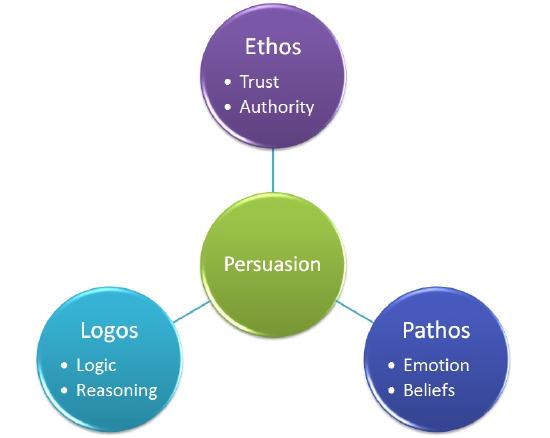
Logical Appeals
Authors using logic to support their claims will include a combination of different types of evidence. These include the following:
- established facts
- case studies
- experiments
- analogies and logical reasoning
- citation of recognized experts on the issue
Authoritative Appeals
Authors using authority to support their claims can also draw from a variety of techniques. These include the following:
- personal anecdotes
- illustration of deep knowledge on the issue
- testimony of those involved first-hand on the issue
Emotional Appeals
Authors using emotion to support their claims again have a deep well of options to do so. These include the following:
- impact studies
As you can see, there is some overlap on these lists. One technique might work simultaneously on multiple levels.
Most texts rely on one of the three as the primary method of support, but may also draw upon one or two others at the same time.
Check your understanding of supporting details by doing this quiz.
Exercise \(\PageIndex{6}\)
Read the paragraph below and find the main idea and supporting details.
My parents were very strict when I was growing up. My mother in particular was always correcting my behavior. One day when I forgot to look both ways when I was crossing the street, my mother made me go back home; she said that I could not go out at all if I could not be safe. My father was more concerned with my grades. Every night he would make me go to my room before I could watch television.
Let’s examine the pattern for this paragraph. The first sentence (1) presents the main idea, that my parents were strict. The second sentence (2) explains what I mean by “strict,” by saying that my mother was strict in correcting my behavior. The third sentence (3) offers an example of how she would correct my behavior. The fourth sentence (4) explains further, that my father was strict when it came to schoolwork, and then the fifth sentence (5) offers an example of how he was strict.
If we were going to diagram the paragraph above, it would look like this:
EXPLAIN (2)-___________________EXPLAIN (4)
EXAMPLE (3) EXAMPLE (5)
Major and Minor Supporting Details
One way to talk about whether a sentence directly supports the main idea (the second level), or indirectly supports the main idea (the third level) is to call them MAJOR detail sentences or MINOR detail sentences. Major details directly explain something about the topic, while minor details offer examples for the Major detail that came right before.
Exercise \(\PageIndex{7}\)
Read the paragraphs, and then identify each sentence as either a main idea, a major detail, or a minor detail sentence.
Single parents have to overcome many obstacles to return to school. If the child is very young, finding quality babysitting can be difficult. Many babysitters are unreliable and that can mean that the parent has to miss many classes, which can hurt their grades. It is also hard to find enough time to study. Children require a lot of attention and are also noisy, and that can interfere with a parent's ability to complete their homework. Finally, raising children is expensive. Many single parents discover that they can’t meet the costs of both raising children and paying for tuition, books, and fees.
Sentence #1: Sentence #2: Sentence #3: Sentence #4: Sentence #5: Sentence #6: Sentence #7:
My grandmother turned 70 last year and celebrated by going skydiving. She said she always wanted to try and figured it was now or never. Many people think that when you get older you can no longer do fun things, but this is not true. The senior center in town offers dance lessons and also takes groups to the art museum. The classes are always full because so many people want to try new things. Towns are even developing senior living communities around activities such as golf and tennis. Those communities are very popular because people like to live with others who share their interests.
Sentence #1: Sentence #2: Sentence #3: Sentence #4: Sentence #5: Sentence #6: Sentence #7
Exercise \(\PageIndex{8}\)
Below you will find several main idea sentences. Provide appropriate supporting sentences following the pattern of Major-Minor-Major- Minor.
1. It is not a good idea to watch a lot of television. Major: Minor: Major: Minor:
2. Coaches have good reasons to be firm with the players on their team. Major: Minor: Major: Minor:
3. Many people believe it is a bad idea to spank children. Major: Minor: Major: Minor:
4. There are several steps I can take to be successful in college.
Major: Minor: Major: Minor:
Reading-Writing Connection: Supporting Details
Exercise \(\PageIndex{9}\)
Return to the Thesis exercise you did previously. As part of that exercise, you identified two topic sentences from your selected reading. Now, look more closely at the paragraphs where those two topic sentences came from.
- Write a paragraph that identifies the type of support that each paragraph from the reading uses to reinforce each of those two topic sentences. Are they narrative or personal examples? Are they facts or statistics? Are they quotes or paraphrases from research materials?
- Write another paragraph that compares the effectiveness of the supporting claims of one of the selected paragraphs against the other one. Which seems more successful in its goal? Why do you feel that way?
Contributors
- Adapted from English 9Y Pre-College English . Provided by: Open Course Library. CC BY 3.0
- Adapted from Thesis Statements and Topic Sentences . Provided by: Lumen Learning. CC-BY-NC-SA
- Adapted from Methods of Discovery: A Guide to Research Writing . Authored by: Pavel Zemliansky. Provided by: Libretexts. CC BY: Attribution
This page last updated June 6, 2020.
12 Tips To Make Teaching Main Idea Easier

Teaching students the concept of finding the main idea in a text is tricky. The term has a variety of synonyms and related ideas . There’s scientific proof that interesting but extraneous details can become more memorable to readers than the main idea. Plus, learning about the main idea doesn’t always lead to better performance on standardized tests . If you’re not seeing tangible results in your students’ test scores you might wonder why you should care about teaching it at all. We’re giving you 12 tips to make teaching main idea to your students easier and to see why teaching this skill matters, even if it’s not directly reflected in test results:
Why is it difficult to teach students to find the main idea?
12 Tips for teaching the main idea to your students
Teaching the main idea with Newsela
According to author and literacy expert Timothy Shanahan, finding the main idea in a text or passage isn’t really a literacy skill . He makes this claim because the main idea is specific to each text. It’s not the same as other literacy skills that students can practice through repetition or even memorization because they’ll never have the same main idea twice. That makes it harder for you to teach them HOW to do this correctly. It’s not like a mathematical formula. They can’t do a repetitive process and get the “correct” answer every time.
Plus there are discrepancies in how students may write or identify the main idea, meaning that even when there’s only “one right answer” there’s also not just “one right answer.” Take an example from the article “Kids are abuzz with activities to help save bees” from our Newsela Earth Month: Environmentalism and Conservation text set :
Both main idea versions in this example are accurate. They both cover the main points of the article, with more or less specificity in certain areas. If two students gave these answers as the main idea of the text, neither would be wrong.
12 tips for teaching the main idea to your students
Because the main idea can be a difficult concept to teach (and understand!) not every strategy works for every student, text, or lesson. Here are some options you can use throughout the year to help your students practice finding the main idea to make the concept easier to understand:
1. Start with topics
Before you even have students pick up a text, start with a lesson or refresher on identifying the topics of a text. This can be as simple as doing an activity where students have to find the common bond between a few items or ideas. For older students, you could play a game like “Tribond” where you provide three statements and students try to figure out what they have in common. For example, you could ask them what Penguins, Panthers, and Bruins all have in common. They’re all hockey team names (and animals, too!).
For younger students, try a mystery bag activity. Add three or four small items or images with a theme to a paper bag. Call on students to take turns pulling items out of the bag and work together to try to decide what they have in common. For example, a toothbrush, toothpaste, and dental floss all have teeth or tools to clean your teeth in common. These activities help students think about how items and ideas relate to each other, which is a large part of being able to find and state the main idea.
After students understand how to identify topics, you can help them use the same thought process while reading to find connections in the text. You can write these potential topics on the board or have students record them in a notebook. Circle the ones that feel most important or relevant to the text. Then you can model how they should think about which one is the right starting point for their main idea. Ask questions like, What is the author saying about these topics? or How can we write a sentence that describes what this text is about, using our topic as a guide?
2. Teach about the main idea and key details together
The main ideas and key details are two literacy skills that go together. Students can’t find the main idea if they can’t identify key details. They can’t determine what information is a key detail if they don’t have a main idea to connect them all. Instead of teaching these skills in isolation, teach them together. This can help students scaffold the thinking, research, and analysis skills necessary to make meaning from the texts they read .
3. Teach the main idea as part of summarizing
Because of the potential subjective nature of this skill, Shanahan recommends teaching it as part of a larger reading strategy like summarizing. Summarizing helps support students’ reading comprehension by giving them a full overview of a text, either paragraph by paragraph or holistically after reading. It’s easier for students to look at a group of shorter summaries, such as one for each paragraph, and decide which details are MOST important, the ones that make up the one-sentence main idea.
4. Vary the types of texts you use
The main idea is specific to the text you’re reading, so it’s important to help students find the main ideas in different types of texts. Use both literary and informational texts in your lessons. Anything goes: poems, short stories, essays, novels, news articles, speech transcripts. You get the idea. Different types of texts will also vary in length, difficulty, and topic, giving students a wide range of content for practice. The more exposure students have to finding the main idea in different kinds of texts, the better they can get at mastering the concept.
Newsela’s content library helps with this. Newsela ELA has 15,000+ pieces of literary and informational content on topics that align with your curriculum, students’ interests, and everything in between. Text leveling allows you to adjust the complexity of what students are reading to show them how the main idea doesn’t change even when the vocabulary or sentence structure does.
5. Pay attention to how you model finding the main idea
Shanahan recommends what he calls, “the gradual release of responsibility” when teaching about finding the main idea. But how does it work? When you’re modeling the process of finding the main idea, you start by explicitly telling them what to do. Then you pass the decision-making responsibility to them as you practice and repeat the process. Here’s what this might look like when doing multiple read-alouds:
Modeling the right thinking and then giving more responsibility to your students allows them to start finding the main idea independently in any text, not just the ones you cover in class. Newsela ELA annotations can help with modeling, especially when you ask students to highlight key details or remove extraneous ones to help them summarize.
New to Newsela?
Sign up for Newsela Lite to practice skills and build a literacy routine that students love—for free!
6. Add visuals to the text
Adding visuals to written text can help make ideas stick. If your text has little or no images, you can add some to help students connect the words with a tangible concept. When modeling how to find the main idea, you can use free stock images with fair use copyright to illustrate key points of a text.
For example, if you were teaching with the article “The early history of football’s forward pass,” (in our Super Bowl text set ) you may use images of things like a football, Glenn Scobey Warner, or someone throwing a forward pass to illustrate the main concepts of the article. If images aren’t available for the text or topic you’re covering, you can ask students to draw their own illustrations.
7. Look at the first and last sentences for clues
While the topic or conclusion sentence doesn’t always include the information you need to find the main idea, both can be good starting points for research. They often include at least some clues to the theme, topic, main characters, primary conflict, or resolution of the story, all of which can be key components of writing a main idea statement.
As a pre-reading activity, have students read both the topic and conclusion sentence of the text and have them predict what they think the text will be about. They'll see these sentences again when they read the text (or reread it multiple times for close reading!). Have students hold onto their predictions and after reading have them use key details from the text to support or disprove their predictions. Then have them use all of that information to decide the main idea.
8. Use titles to your advantage
Like the topic and conclusion sentences, the title of the text or article can also provide clues to the main idea. You can do the same pre-reading activity and have students read the title and predict what they think the text is about. They can use that information after reading—with the key details they find in the text—to determine the main idea.
For example, take an article titled “Online posting can have very serious consequences” from our novel study on the book “One of Us Is Lying” by Karen McManus. Students who read this title may predict that the article is about social media, sharing information online, getting in trouble, or other similar topics. They can find key details and evidence to support or refute their predictions as they read. If a text has headings and subheadings you can include these in your pre-reading activity, too.
9. Use keywords
Some texts include keywords or key terms as a text feature. These words and phrases are bolded, italicized, underlined, or otherwise stand out from the rest of the text so students know they’re important. In traditional textbooks, there’s often a glossary in the back that lists the definitions for these terms. With dynamic programs, students can often click the word to view the definition onscreen. Newsela ELA Power Words work like dynamic keywords to highlight Tier III vocabulary words for students, providing background knowledge and context.
Analyzing and reviewing keywords and their definitions can help draw students’ attention to what’s important in a text. You can also have students find synonyms and antonyms for the keywords throughout the passage. Looking for repeated references can help students recognize some of the important topics in a text.
10. Use main idea prompts
If students aren’t sure where to begin when writing a main idea sentence, they may feel overwhelmed. You can use a fill-in-the-blank prompt activity to get them started. Before reading, provide students with prompts like:
The prompt or prompts you choose may depend on whether you’re using an informational or literary text and the complexity of the lesson. Asking students to fill in the blanks can feel less intimidating than creating a main idea sentence from scratch.
11. Provide main idea choices
A text only has one main idea. But literacy skills aren’t math and there isn’t always one right answer. We can use that variety to our advantage when teaching students about the main idea. Do an exercise where you have students read a passage or a text and give them four potential main ideas. Depending on how long you’ve been practicing the skill, you could also ask them to generate four potential main ideas of their own. Next, have students number the four statements in the following convention:
This activity can help students sort through their ideas of what they think a main idea might be while visually seeing how to narrow the information down to just the highlights.
12. Review, review, review
The more you practice, the easier anything gets. You can have students find the main idea of any text you read as a class, or even reading that they do independently. The more opportunities you provide for practice and encourage them to do it on their own, the more they’ll internalize the steps needed to master the skill. The standards and skill-aligned multiple-choice quizzes on all Newsela authentic texts make it easier for you to discover what your students know and where they need more help practicing this skill.
Teaching the main idea with Newsela ELA
Although the main idea is a unique skill, it's easier to teach and track student progress when you have the right scaffolds and support for both you and your students. With Newsela ELA, it’s easy to provide literary and informational texts to help students find the main idea with a variety of relevant, real-world content.
And coming for back-to-school ‘24, Newsela ELA will have updated reporting features that help you look in on students’ skills progress with ease. You can identify classroom trends and patterns with the new class overview module. It provides an aggregate summary of classroom performance. You’ll also see students’ reading skills clearly displayed so you can connect those areas of growth directly to the content you’re searching for on Newsela. Not a Newsela customer yet? Sign up for Newsela Lite to get free access to content and skill-building scaffolds you need to teach students how to find the main idea in your lessons.
If you liked this article...
Browse more great content from Newsela.
Theme vs Main Idea: What’s the Difference?
Help students discover the difference in theme vs main idea and how to clearly define other related topics and literacy skills for them throughout your lessons.
What Are Key Details? Make the Concept Stick for Students
Discover what key details are in literacy instruction and get tips on how to make the skill stick for students in different types of ELA instruction.
11 Key Details Examples You’ll Actually Want To Teach
Find articles and content that include examples of key details you can share with your students to help them understand & master this literacy skill.
Inspire the desire to learn.
Ready to engage, support, and grow every learner.
Finding the main idea of the text

Why users choose our The main idea
TextAdviser is an innovative online service designed to automatically extract and identify the main idea from any given text, making it an indispensable tool for various users. Its primary function is to condense lengthy texts by selecting and summarizing the most crucial sentences that capture the essence of the author's message.
For students and schoolchildren, TextAdviser proves invaluable in the realm of education. Throughout their academic journey, students encounter tasks that require them to discern and articulate the main idea of a text. This skill is not only crucial for comprehension but also enhances their ability to retain and recall information effectively. TextAdviser simplifies this process, helping students excel in their studies and standardized exams.
Professionals dealing with substantial volumes of text content also stand to benefit from TextAdviser. Whether it's researchers, content creators, or professionals in various fields, the service offers a means to significantly reduce the time spent reading through extensive documents, thus enhancing overall productivity.
Using TextAdviser is a straightforward process, making it accessible to users of all backgrounds. Users simply need to copy the text they want to analyze to their clipboard and then paste it into the program's working window. After pasting, they can click the "Find" button, and TextAdviser automatically detects and records the main idea of the text.
The service employs a sophisticated algorithm to determine the main idea effectively:
- Text Analysis: The program reads the provided text thoroughly.
- Keyword and Phrase Analysis: It identifies keywords and phrases, as well as their synonyms, which are repeated frequently within the text. These keywords are essential in conveying the text's main idea.
- Subheading and Paragraph Examination: The algorithm divides the text into paragraphs, recognizing micro-themes created by the author. This step helps identify key sections that are integral to understanding the topic.
- Logic Evaluation: The program traces the logical development of the story throughout the text. Understanding the logical flow is vital in identifying the main message.
- Utilizing the Text Title: If the user provides the title of the text along with its content, TextAdviser considers this additional context. Often, the title contains elements of the main idea, even if it is metaphorical, paradoxical, or associative.
TextAdviser offers different character limitations depending on the user's status:
- Site guests can analyze up to 10,000 characters at once.
- Registered users have a limit of 15,000 characters.
- PRO version users, in addition to an extended character limit of 200,000 characters, enjoy an ad-free experience and a separate queue for their requests. They can also conveniently refill their balance as needed before utilizing the PRO version's enhanced features.
- In summary, TextAdviser is a user-friendly, online service designed to help students, professionals, and anyone dealing with extensive text content quickly and accurately identify the main idea of a text. It streamlines the process, making it an indispensable tool for enhancing comprehension, productivity, and information retention.
How to Define the Main Idea
Defining the main idea requires a keen eye and a strategic approach:
Careful Reading: Begin by thoroughly reading the text. Absorb the information and try to grasp the overall context and tone.
Identify Keywords: Pay attention to keywords and phrases that frequently appear. These are often indicators of the central theme.
Understand Supporting Details: The main idea is usually supported by details and examples. Recognize the elements that reinforce the core concept.
How to Find the Main Idea
Locating the main idea involves a combination of reading techniques and critical thinking:
Structural Elements: Examine the structure of the text. Headings, subheadings, and transitions can guide you toward the central theme.
First and Last: Often, the main idea is introduced in the first sentence or paragraph and summarized in the last. Focus on these areas for key insights.
Repeated Concepts: Identify recurring themes or ideas. Repetition can signal the significance of a particular concept.
Avoid Main Idea Mistakes
Recognizing and steering clear of common mistakes is crucial in honing your main idea identification skills:
Don’t Confuse Details with the Main Idea: Details support the main idea but are not the main idea themselves. Distinguish between overarching themes and supporting information.
Watch for Red Herrings: Be cautious of distractors or irrelevant information that might divert your attention from the core concept.
Consider the Context: Ensure that your interpretation aligns with the overall context of the text. Misjudging context can lead to inaccuracies in identifying the main idea.
Where Are The Main Ideas Found?
Understanding where to look for main ideas can simplify the process:
Headings and Subheadings: Often, the main idea of a section is encapsulated in its heading or subheading.
Topic Sentences: In paragraphs, the main idea is typically expressed in the topic sentence. Identify the sentence that encapsulates the central theme.
Concluding Remarks: The conclusion of a text may summarize the main idea, providing a succinct overview.
How To Determine If I Have Selected the Correct Main Idea of a Paragraph?
Verifying your main idea selection is a crucial step in ensuring accuracy:
Check Consistency: Confirm that your selected main idea aligns with the details and supporting information provided in the paragraph.
Review the Context: Reassess your choice in the context of the entire text. Ensure that the main idea you've identified fits seamlessly into the broader narrative.
Seek Feedback: Discuss your interpretation with others. Their perspectives can offer valuable insights and help refine your understanding.
2024-04-23 16:02:38
2024-02-22 23:27:27
- Reading Comprehension Worksheets
- Inferences Worksheets
- Context Clues Worksheets
- Theme Worksheets
Main Idea Worksheets
- Reading Games
- Summary Worksheets
- Online Tests
- Figurative Language Worksheets
- Short Stories with Questions
- Nonfiction Passages
- Genre Worksheets
BECOME A MEMBER!
Are you looking for main idea worksheets and resources? This page features a collection of high-quality worksheets and a PowerPoint lesson! Many students have difficulties identifying main ideas in nonfiction texts. I hope that these resources will help.
Identifying main ideas may come simply and naturally to good readers. But it is actually a two or three step process . Struggling readers may trip up on any one of those steps. Here are some practice activities. Students can try to identify the main idea in a variety of texts with these main idea worksheets.

Main Idea Common Core State Standards
149 comments.
These are wonderful resources. Bless you all!
Joy Perkins
As always – brilliant material
Margaret Chavis
Great for assessing and remediation
EMELIA C. PALURAY
I’m gratefully happy to use the worksheets from this website. thanks for the selfless effort you’ve impartially exerted. wonderful and amazing God bless everyone.
Valuable website for everyone
Thank you so much. This website has helped me understand lots of figurative language! Thank you again!!! Best wishes, Satnaam
very good website thanks for making!<3
Leave a Reply Cancel reply
Your email address will not be published. Required fields are marked *
- Author's Purpose Worksheets
- Characterization Worksheets
- Conflict Worksheets
- Fact and Opinion Worksheets
- Figurative Language Activities
- Figurative Language Poems with Questions
- Genre Activities
- Irony Worksheets
- Making Predictions
- Mood Worksheets
- Nonfiction Passages and Functional Texts
- Parts of Speech Worksheets
- Poetic Devices
- Point of View Worksheets
- School Project Ideas
- Setting Worksheets
- Simile and Metaphor Worksheets
- Story Structure Worksheets
- Text Structure Worksheets
- Tone Worksheets
- ALL PAGES AND WORKSHEETS
If you're seeing this message, it means we're having trouble loading external resources on our website.
If you're behind a web filter, please make sure that the domains *.kastatic.org and *.kasandbox.org are unblocked.
To log in and use all the features of Khan Academy, please enable JavaScript in your browser.
Digital SAT Reading and Writing
Course: digital sat reading and writing > unit 2, central ideas and details | lesson.
- Central Ideas and Details — Worked example
- Central Ideas and Details — Quick example
- Central ideas and details: foundations
What are "central ideas and details" questions?
- (Choice A) Before Farmer’s research, historians had largely ignored the intellectual dimensions of the Black Power movement. A Before Farmer’s research, historians had largely ignored the intellectual dimensions of the Black Power movement.
- (Choice B) Farmer’s methods and research have enriched the historical understanding of the Black Power movement and Black women’s contributions to it. B Farmer’s methods and research have enriched the historical understanding of the Black Power movement and Black women’s contributions to it.
- (Choice C) Other historians of the Black Power movement have criticized Farmer’s use of unconventional primary sources. C Other historians of the Black Power movement have criticized Farmer’s use of unconventional primary sources.
- (Choice D) The figures in the Black Power movement whom historians tend to cite would have agreed with Farmer’s conclusions about women’s roles in the movement. D The figures in the Black Power movement whom historians tend to cite would have agreed with Farmer’s conclusions about women’s roles in the movement.
- Histories of the Black Power movement tend to focus on men.
- Ashley D. Farmer studies a wider variety of sources.
- Farmer's work increases understanding of Black Power movement, especially women's roles.
"Farmer has improved the study of the Black Power movement by exploring the roles of women."
Choice A actually says the opposite of what we learned in the passage. We're told that there were " many intellectual histories" of the Black Power movement before Farmer's. We can eliminate this choice.
Choice C introduces information not included in the passage. The text doesn't mention what other historians think of Farmer's research. If it's not mentioned, then it can't be a "main idea". We can eliminate this choice.
Choice D introduces information not included in the passage. We're not told about the beliefs of "figures in the Black Power movement." If the text doesn't mention this information, then it can't be a "main idea". We can eliminate this choice.
How should we think about central ideas and details questions?
Central ideas.
- cover a majority of the details introduced in the text.
- mention any particular points of emphasis from the text.
- focus too intently on just one detail from the text.
- introduce new ideas not addressed within the text.
- contradict information from the text.
How to approach central ideas and details questions
Step 1: Summarize the text in your own words
Step 2: Determine the task
Step 3: Revisit the text
Step 4: Predict and eliminate
"Ashley D. Farmer has improved the study of the Black Power movement by exploring the roles of women."
Stay specific
Choice C introduces information not included in the passage. The text doesn't mention what "other historians" think of Farmer's research.
Keep your prediction as short and simple as possible
Use keywords as a map.
- (Choice A) He isn’t sure that other guests at the inn will be welcoming of sailors. A He isn’t sure that other guests at the inn will be welcoming of sailors.
- (Choice B) He’s trying to secure a job as part of the crew on a new ship. B He’s trying to secure a job as part of the crew on a new ship.
- (Choice C) He’s hoping to find an old friend and fellow sailor. C He’s hoping to find an old friend and fellow sailor.
- (Choice D) He doesn’t want to encounter any other sailor unexpectedly. D He doesn’t want to encounter any other sailor unexpectedly.
Every day when [Bill] came back from his stroll he would ask if any seafaring men had gone by along the road.
At first we thought it was the want of company of his own kind that made him ask this question, but at last we began to see he was desirous to avoid them.
"Bill wants to stay away from sailors".
Want to join the conversation?
- Upvote Button navigates to signup page
- Downvote Button navigates to signup page
- Flag Button navigates to signup page

- Share on Facebook
- Share on Twitter
- Share via E-mail

Cascade PBS Ideas Festival
Journalists, politicians, authors and newsmakers from around the world come together.
Revisionist History: Unlocked and Unloaded
Podcaster Malcolm Gladwell discusses everything Americans get wrong about guns with activist David Hogg and trauma surgeon Babak Sarani.
- Copy share link
- Share on Reddit
- Credits © Cascade PBS, Published 5/18/24 Cascade PBS Ideas Festival ×
Tug of War: Covering the Crisis in the Middle East
Text me back: a u.s. supreme court roast, the journal: economy anxiety and the election, hear me out: living history, critics at large: crazy for crime, left, right & center: serious about satire, post reports: identity crisis, radio atlantic: ai elections, a word: race and politics.
Revisionist History is Malcolm Gladwell’s journey through the overlooked and the misunderstood. Every episode re-examines something from the past — an event, a person, an idea, even a song — and asks whether we got it right the first time. Because sometimes the past deserves a second chance. As part of the Cascade PBS Ideas Festival, this episode is the culmination of a six-part series from Revisionist History covering everything Americans get wrong about guns. Gladwell hosts a conversation with gun control activist David Hogg and trauma surgeon Dr. Babak Sarani.
Gladwell asks Dr. Sarani to describe his efforts to save victims of gun violence in a hospital setting, with a shocking number of victims being shot multiple times, and the surprising difference in fatality rates between injuries caused by handguns compared to assault weapons.
Hogg talks about his advocacy for stricter gun control laws in the wake of surviving the Parkland mass shooting. He talks about preventing suicide and accidental firearm deaths, championing legislative reforms that specifically helped save his own mother from threats by an NRA supporter.
Despite a difficult road paved by changes to the balance of the Supreme Court, both guests give their reasons for hope and optimism, including the one thing they think will make the biggest difference in the immediate future.
This conversation was recorded in Seattle on May 4, 2024.
Listen to full uncut episodes on the Cascade PBS Ideas Festival podcast at crosscut.com/podcast .
Smart Elections: is AI the Next Wave in Electoral Management?
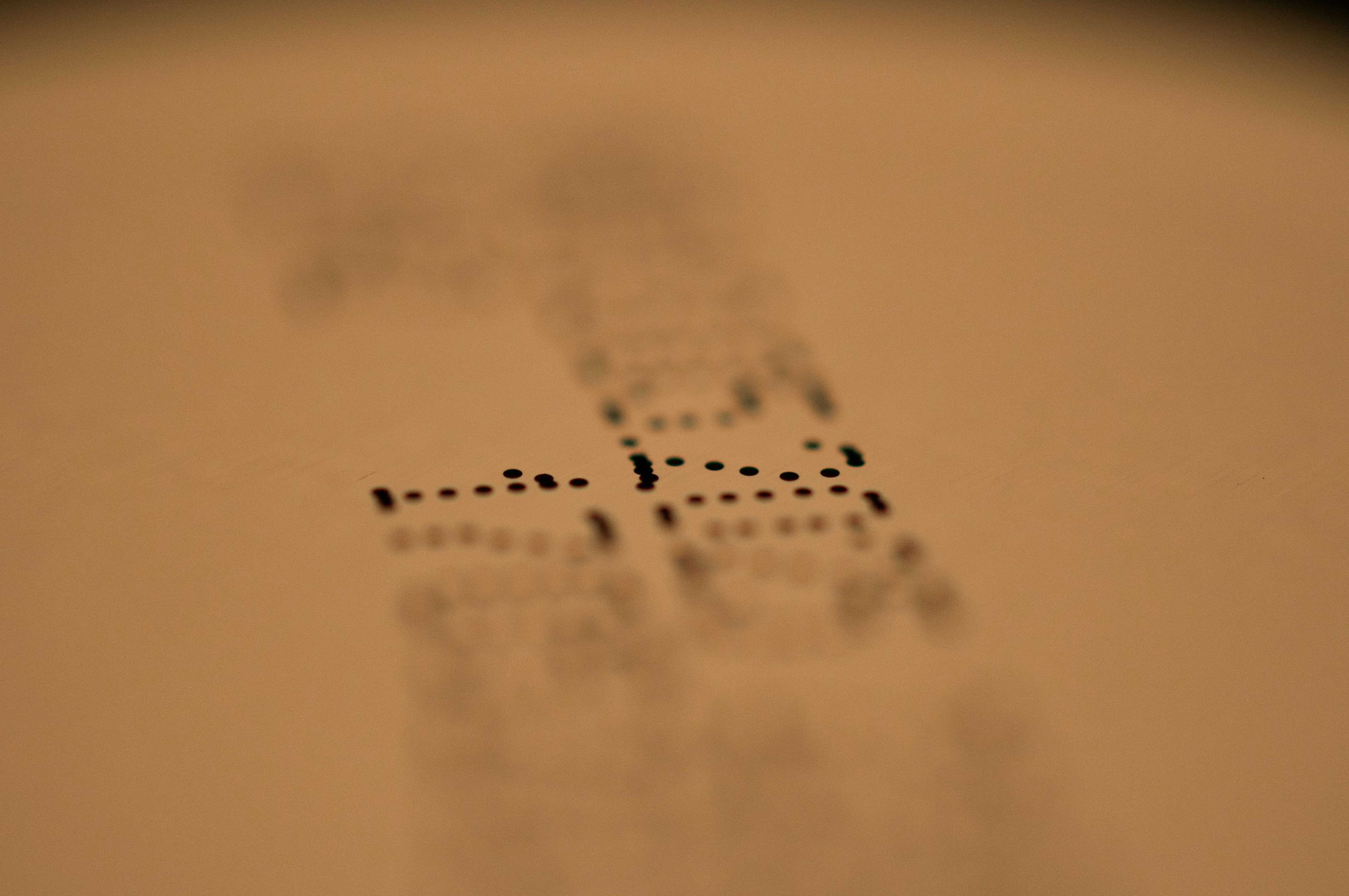
The electoral Supercycle year of 2024 is giving evidence to the already significant impact of artificial intelligence (AI) on elections. AI's effect on democracy is inevitably set to escalate as the AI industry is currently experiencing an explosive annual growth rate of 36.5%. All the while, AI remains largely unregulated in many countries. Although many EMBs have been using systems that would qualify as AI for years, new developments in AI tech present new challenges and opportunities. While many focus on its disruptive character, AI powered instruments hold great potential to engender democratic norms and uphold free and fair elections. To secure AI’s potential to benefit democracy, IDEA is delving into how AI can be, and already is, used by electoral management in order to protect the integrity of the electoral process.
The advancing capabilities of AI systems hold the potential to enhance electoral accessibility, protect information integrity and facilitate logistical planning. Systems can help EMBs algorithmically streamline voter list management, counteract the spread of electoral disinformation, and detect anomalies in election results. On the flipside, handing over the responsibilities of electoral management to AI systems without the right cautionary measures could entail unpredictable and harmful consequences. This uncertain fate in part stems from a lack of interpretability in the operational processes behind AI computations, so called ‘black boxes’, which obfuscates why models produce specific results. A lack of understanding risks resulting in erroneous output (generative AI ‘hallucinations’), inconspicuous discrepancies and discriminatory biases which may seriously undermine the fairness of elections if implemented without considerate human oversight.
The core responsibility for the oversight of how AI is implemented in elections lies in the hands of EMBs. Electoral authorities’ understanding of AI implementation, the risks involved and how to mitigate adverse effects directly determines the technologies’ efficacy and reliability for democracy. Despite the urgent need to strengthen knowledge on AI in electoral management, research on the topic is scarce. This creates obstacles not only in the advancement of AI to benefit electoral processes, but also hampers EMBs’ abilities to effectively recognize and tackle the potential uses of AI to disrupt elections. The effects of this can be seen on a global scale, as countries hosting elections struggle to keep up with disinformation narratives made possible by Generative AI technologies, such as deepfakes and AI-scripted fake account networks.
In response to this increasingly salient challenge, IDEA has created a resource for EMBs considering using AI for elections and electoral management. In the report ‘Artificial Intelligence for Electoral Management’, we overview both existing and possible future use-cases of AI by EMBs, including their implementation, possible concerning implications and available mitigation strategies. As AI use-cases are significantly affected by the context in which they are implemented, the report also delves into how AI is used by other actors seeking to influence elections and how AI regulation could impact the work of electoral authorities. The publication is a key contribution to IDEA’s mandate to support democratic institutions in harnessing technological advancement to foster democratic values. Support which is crucial to develop and adapt to the new technological paradigm of elections.
The publication was recently launched in Washington D.C. at an event hosted by the Canadian Embassy and with the participation of Microsoft, the National Democratic Institute and the German Marshall Fund. Watch the full recording of the event here .

About the authors

The Eighth Melbourne Forum on Constitution Building in Asia and the Pacific

Global leaders sign open letter urging newly elected EU leaders to defend democracy

50/50 Group Sierra Leone hosts National Dialogue on Post-Election Gender Audit Findings
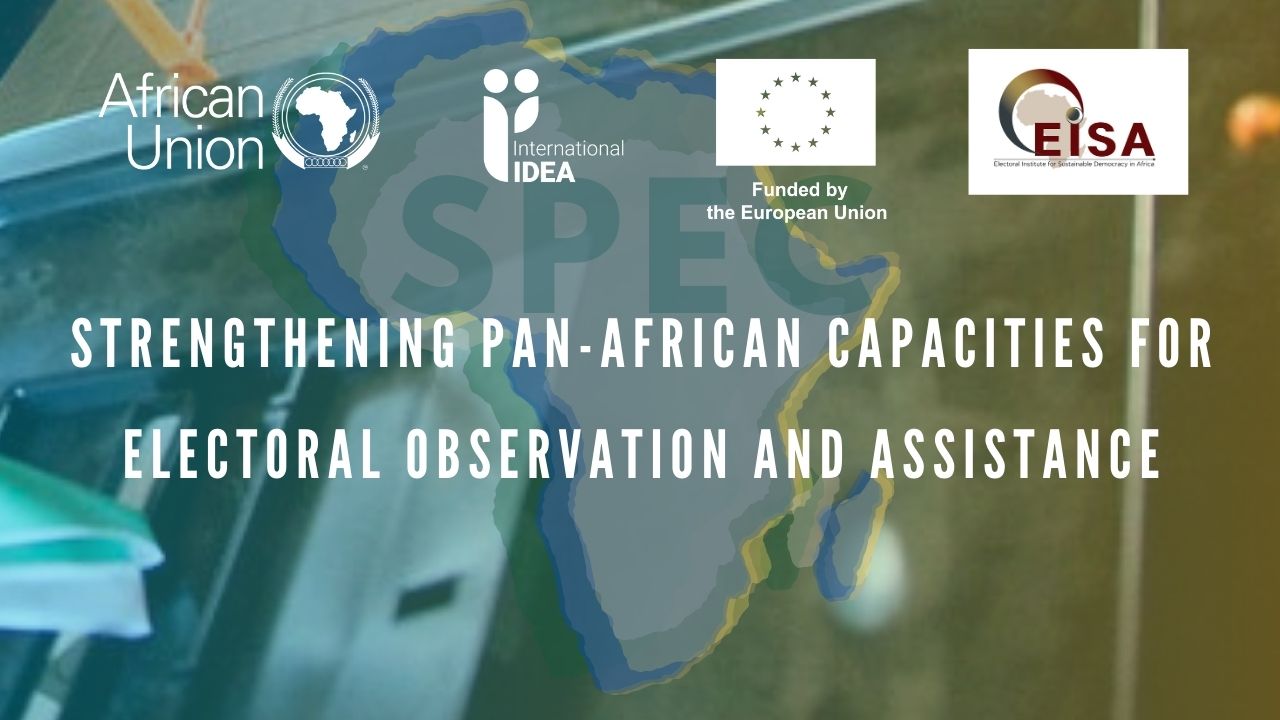
Launch event: Strengthening Pan-African capacities for electoral observation and assistance
Cookie notice.
Our Cookies Policy and Privacy Policy have changed. Please read them to understand your rights and obligations, including how you can use our resources.
By continuing to use this site, without changing your settings, you are indicating that you accept this policy.

Alexa Routines

The easiest way to get started is with Featured Routines
How to enable a featured routine.
- Open the Alexa app
- Select ‘More’ from the bottom navigation
- Select Routines from the menu
- Tap ‘Featured’ and tap on the name of a Featured Routine, then tap enable and your new Routine is ready to use.
- You can also enable a Featured Routine by voice - try one of the Routines below.

- “Alexa, enable the Good Morning Routine” Alexa will wish you good morning, tell you something new, then play your Flash Briefing.
- “Alexa, enable the Start my Day Routine” Alexa will tell you news, traffic, and more.
- “Alexa, enable the Screen Time Routine” Alexa will keep track of an hour of screen time.
- “Alexa, enable the Weather after Alarm Routine” Alexa will tell you the weather when you dismiss your alarm.
- “Alexa, enable the Good Night Routine” Alexa will wish you good night and play sleep sounds.
Build your own
Home automation made easy.


IMAGES
VIDEO
COMMENTS
The main idea is the point or message - what an author presents and what a reader takes from a text. Searching for that main idea is a very important activity in understanding a text. It is usually found in the opening paragraph when the author is setting up the topic and expressing the thesis. However, the location can vary according to the ...
The main idea of a paragraph is the primary point or concept that the author wants to communicate to the readers about the topic. Hence, in a paragraph, when the main idea is stated directly, it is expressed in what is called the topic sentence. It gives the overarching idea of what the paragraph is about and is supported by the details in ...
1. The main idea is not a single detail from the passage. Details are the specific pieces of information that support or explain the main idea. For example, if the main idea of a passage is that eating healthy is important, some of the details might include information about the benefits of eating healthy or examples of healthy foods to eat.
Main Idea Definition. Main Idea includes the overall message of the text that a writer intends to convey to the audience.Almost all genres of literature have one or two main ideas in them. However, the main idea in literature is not limited to one sentence or paragraph; instead, it develops and grows throughout the text. It works as the central, unifying element of the story which ties ...
Always read an entire text carefully to get a complete understanding of what the author is trying to say. Here are a few other strategies that will help you identify a text's central idea: Look for clues in the title and headings: Sometimes, the central idea is stated right in the title or headings of a text.
About. Transcript. In this video, we'll discuss the main idea of a text: the key information the author wants you to understand. Figuring out the main idea of a text is different from summarizing it. A summary includes key details, but the main idea is a broader concept that the details add up to. Questions.
3. Restate the main idea in 10 words or less. You can model this strategy for your students by first walking them through the process. Project the text onto the whiteboard for shared reading and, with focused support and prompting, have them answer the initial questions.
Think of the main idea as the point - The main idea is the primary argument or claim discussed by the author, around which all other supporting details and explanations revolve.; Make sure you read the full text - You can determine the main idea by reading the full text, annotating its key points, summarising, and looking for any repeating ideas or statements.
Main Idea. Finding the main idea in a piece of writing is a basic reading skill. No matter what type of expository text you read, the primary comprehension goal is to identify the main idea: the most important point that the writer wants to communicate. Main ideas are often stated toward the start of a text, usually in an introductory paragraph.
Finding the Main Idea is more than just figuring out what general point the author is trying to make. It's about recognizing that we can come up with several main ideas, but the "best" main idea has strong support from the entire article. How to EVALUATE and FIND THE BEST MAIN IDEA (4 PRO TIPS): 1. Focus on the BIG PICTURE (the entire article). Summarize the entire article in a word or ...
The main idea is what a passage is about and answers the question: what is being discussed? Learn how to pinpoint main ideas with a few simple strategies. ... If so, you've probably found the main idea. Being able to summarize the text in your own words helps you arrive at the main idea. Finding the Main Idea Examples. Examples of main ideas ...
Main Idea, Purpose, & Audience. Text evaluation and analysis usually start with the core elements of that text: main idea, purpose, and audience. An author needs to consider all three of these elements before writing, as they help determine the author's content and language. As a reader, it's important to ascertain these aspects of a text ...
1. Question the Topic. This is a super simple strategy and can usually help the students discover the main idea of a text… and understand the connection between main idea and author's purpose. First, have students identify the topic of the text. This is usually a single word or phrase.
1.The topic of the paragraph is pyramids. 2. There are three groups of supporting details: age, size, and purpose. 3.The author has organized the supporting details into "characteristics" or "traits" of the pyramids. 4.The author purpose seems to be trying to define a pyramid. Implied Main Idea: Pyramids are structures with several ...
Knowing how to search for and identify the main idea of a piece can help us become better readers—and writers. Here are a few ways to help you locate it.
It is easy to identify a main idea that is directly expressed in the text. Main ideas are often found: at the beginning of paragraphs. The first sentence often explains the subject being discussed in the passage. in the concluding sentences of a paragraph. The main idea can be expressed as a summation of the information in the paragraph as well ...
Here are three of them. 1. Pay attention to the title. Often, it points to the main idea of the text. 2. Notice what words are used repeatedly which will help to identify the topic. Build from the ...
Exercise 3.8.1 3.8. 1. Read the following paragraph and then decide what the main idea is. One myth about exercise is that if a woman lifts weights, she will develop muscles as large as a man's. Without male hormones, however, a woman cannot increase her muscle bulk as much as a man's.
The main idea is what the passage says. The primary purpose is why the author wrote the passage. To answer these questions correctly, you have to be able to identify the most important idea that the passage is trying to establish—the idea that all other ideas and information in the passage are there to support.
Main Idea: The main idea of a text is the central or overarching concept or message that the author is trying to convey to the reader. It encapsulates the text's primary argument or point and ...
11. Provide main idea choices. A text only has one main idea. But literacy skills aren't math and there isn't always one right answer. We can use that variety to our advantage when teaching students about the main idea. Do an exercise where you have students read a passage or a text and give them four potential main ideas.
4.7 based on 5130 reviews. TextAdviser is an innovative online service designed to automatically extract and identify the main idea from any given text, making it an indispensable tool for various users. Its primary function is to condense lengthy texts by selecting and summarizing the most crucial sentences that capture the essence of the ...
Main Idea Worksheet 1. Here is a double-sided main idea worksheet. Students read seven original nonfiction passages and summarize the main idea of each passage. Also, students must think of a title for each passage that relates to the main idea of the text. Suggested reading level for this text: Grade 6-10.
Step 1: Summarize the text in your own words. Don't just skim the passage. Read it closely, and try to summarize the ideas you encounter in your own words. By the time you finish reading, you should have a strong understanding of the information contained in the passage. Step 2: Determine the task.
Revisionist History is Malcolm Gladwell's journey through the overlooked and the misunderstood. Every episode re-examines something from the past — an event, a person, an idea, even a song ...
The electoral Supercycle year of 2024 is giving evidence to the already significant impact of artificial intelligence (AI) on elections. AI's effect on democracy is inevitably set to escalate as the AI industry is currently experiencing an explosive annual growth rate of 36.5%. All the while, AI remains largely unregulated in many countries.
You can now add Fire TV actions to your Alexa Routines. Get started with a Featured Routine like "Alexa, I'm getting a snack" which pauses what you're watching and turns on your smart lights simultaneously. Or if there's a program you watch every day, create a Custom Routine where Alexa turns on the TV and navigates to your favorite program based on scheduled time.